
Visual History Archive (VHA)
User Manual
http://vha.usc.edu
rev July 2023

ii | USC Shoah Foundation
Visual History Archive (VHA) User Manual
Contents
A V H A (VHA) .............................................................................
G S ........................................................................................................................
A O ...........................................................................................................................
R L ............................................................................................................
C ................................................................................................................................
S .........................................................................................................................................
Advanced Search Types ....................................................................................................................................4
Filtering ............................................................................................................................................................5
Dropdown Filters .............................................................................................................................................5
Left Sidebar Filters ...........................................................................................................................................6
Understanding Search Results ..........................................................................................................................9
Saving Searches and Search Results ...............................................................................................................10
T V S ......................................................................................................
Video Player ...................................................................................................................................................13
Provenance, Citations and Options.................................................................................................................14
Segments and Indexing...................................................................................................................................15
Saving a Segment to a Project ........................................................................................................................16
Biographical Prole, Transcript, Subject Terms, People, Map, Find ...............................................................16
Image Slideshow ............................................................................................................................................. 21
K S .......................................................................................................................
Focusing Your Keyword Search ......................................................................................................................23
Keyword Search Example: "What is available in the Visual History Archive about Ukraine?" ......................23
S S..........................................................................................................................
Auto-suggested Subject Terms ......................................................................................................................25
"In Segment" and "In Testimony" Searching .................................................................................................. 27
Subject Search Example: "How did people survive deportations during the Armenian Genocide?" ..............28
P S .............................................................................................................................
Search Bar .......................................................................................................................................................29
Places Browse .................................................................................................................................................30
Draw ............................................................................................................................................................... 31
Place Search Example: "How did Nanjing Massacre survivors speak about the neighborhoods that
comprised the Nanjing International Safety Zone?" .......................................................................................33
P S ...........................................................................................................................
People Search Inputs ......................................................................................................................................35
Filtering a People Search ................................................................................................................................36
People Search Example: "What similarities can be found between Renée Firestone's own testimony and
those in which she served as interviewer?"
...................................................................................................... 37
D ................................................................................................................................
P
....................................................................................................................................
Testimonies in Projects ...................................................................................................................................41
Discussions .....................................................................................................................................................42
Searches ..........................................................................................................................................................42
Public Projects ................................................................................................................................................43
A P M .....................................................................................
H VHA U ................................................................................................................
C USC S F ...........................................................................................
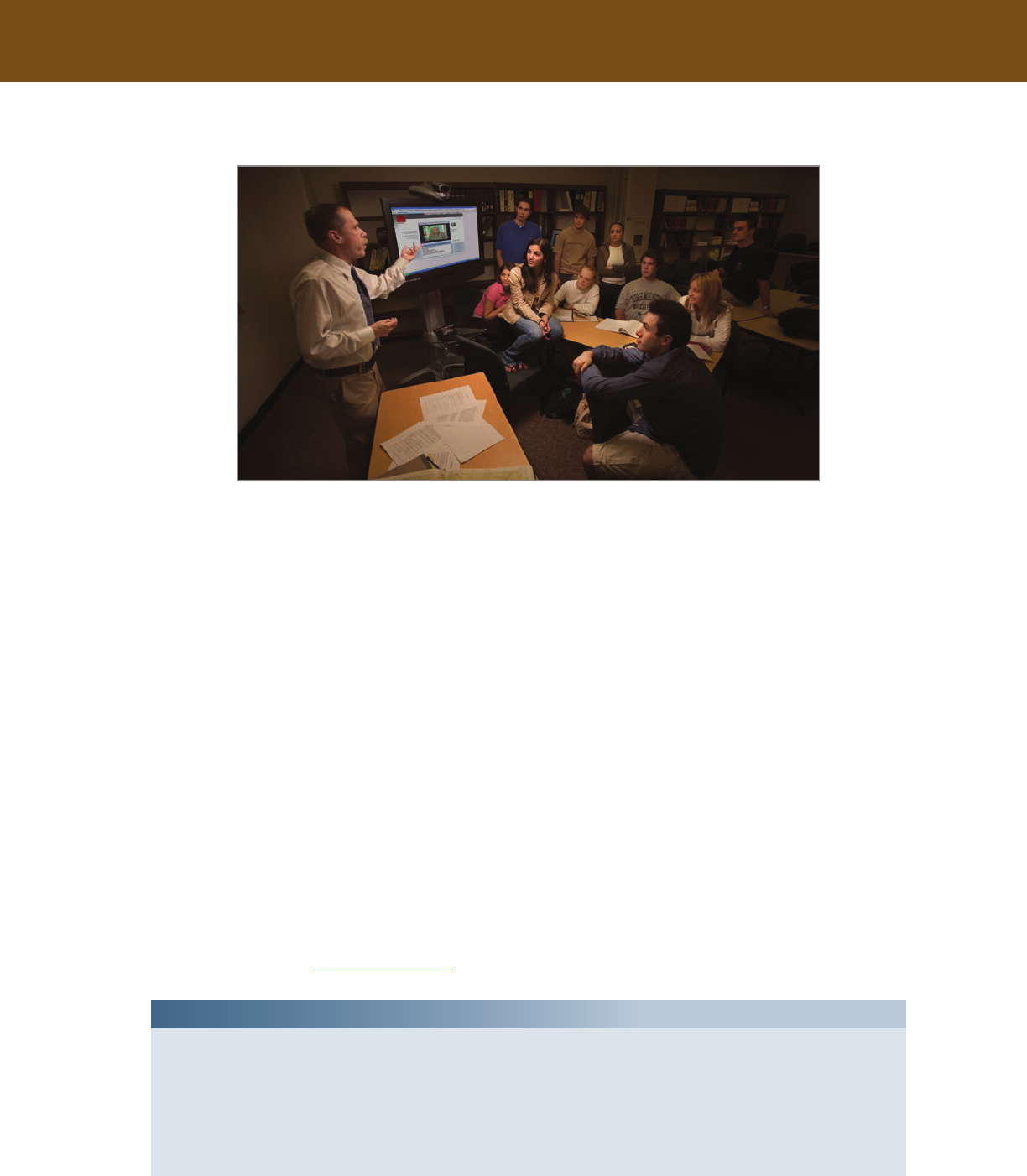
USC Shoah Foundation | 1
Visual History Archive (VHA) User Manual
About the Visual History Archive (VHA)
USC Shoah Foundation’s Visual History Archive (VHA) is a fully searchable online repository
of over 56,000 oral history testimonies from survivors and witnesses of the Holocaust, as well as other
genocides and crimes against humanity. Testimonies available through the VHA have been preserved,
digitized, catalogued and indexed to make them searchable and accessible, both as whole testimonies
and as specic segments.
In addition to being the biggest archive of its kind in the world, the VHA is unique for its
searchability and ease of access. All the testimonies housed in the VHA are divided into searchable
one-minute segments, so the archive is searchable by the minute. is searchability is enabled by
indexing, USC Shoah Foundation’s primary method of describing the content or specic discussions
contained in individual testimonies, with each segment of testimony being assigned a set of
appropriate and searchable indexing terms (including subject, places, people and time terms). ere
are more than 70,000 such terms in the archive.
Getting Started
To access the Visual History Archive search and viewing tool, open your favorite browser and
navigate to the URL: http://vha.usc.edu/.
Note:
The VHA is compatible with most major browsers available on PCs, Macs, mobile devices and
tablets. Windows 10+ and macOS 10.13+ are recommended for desktop and laptop; Android 10+
or iOS 13+ are recommended for mobile.
On mobile, only Keyword Search functionality can be used to navigate the archive; the full VHA
experience is only available for users on a desktop, laptop or tablet.
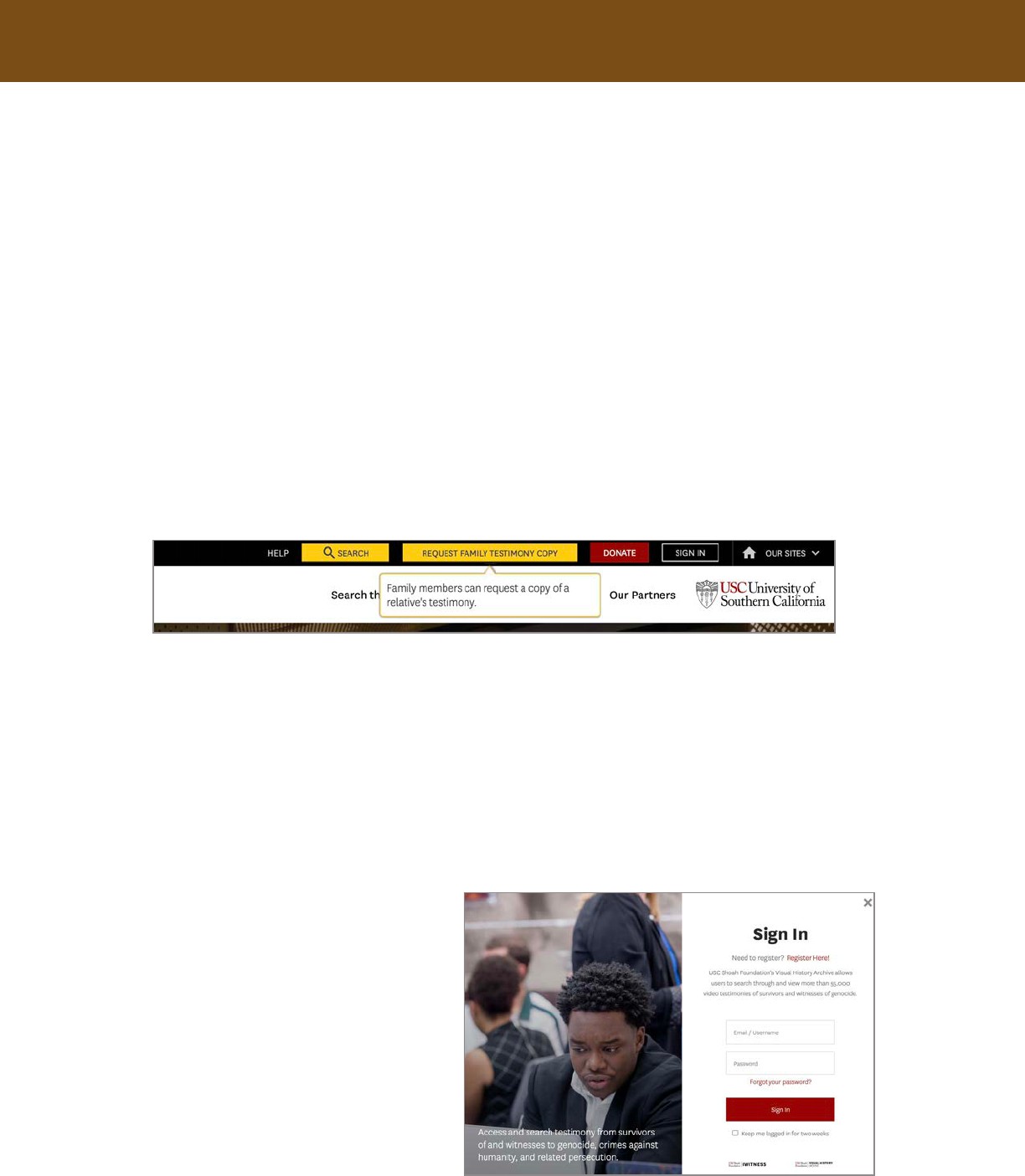
2 | USC Shoah Foundation
Visual History Archive (VHA) User Manual
Access Options
e full Visual History Archive of over 56,000 testimonies is a subscription-based platform
distributed by ProQuest. To view the entire collection, users will need to visit a subscribing Access
Site. Find your nearest Access Site using the map browser available at the Access Sites link in the
VHA footer.
Users who do not have access to subscribing Access Sites may still access and search the VHA at
no cost; as long as they are connected to the internet, these users may view all metadata in the VHA,
but only around ten percent of the testimonies in the VHA will be available to watch.
If you are seeking a digital copy of the testimony of a specific family member, USC Shoah
Foundation can support you, regardless of your proximity to a VHA Access Site. Click Request
Family Testimony Copy at the top of your VHA browser window and place an order at SFI Access, the
Institute’s platform for providing copies of testimonies for viewing or for licensure in a project.
Registration and Login
For online access to the Visual History Archive, a no-cost USC Shoah Foundation website
account is required. VHA users located at an Access Site will not need a login to search or view
testimony; however, for the best VHA experience—including our Dashboard and Projects features for
tracking and sharing VHA work—an account is highly recommended for all users.
When you rst go to the Visual History Archive, clicking either Sign In or Search the VHA will
bring you to the Sign In screen.
On the Sign In screen, enter your
Username and Password, and click Log In.
If you do not have a Username and
Password, you must create your own. To
proceed, click Register Here! and ll in the
appropriate information. You should choose
a Username and Password that you will
easily remember. By registering, you will be
also able to access your Search History and
save your search results and parameters to
your Projects for later review.

USC Shoah Foundation | 3
Visual History Archive (VHA) User Manual
e Sign In page also oers the ability to change a forgotten password. Just click on Forgot your
password? to go to the Password Recovery page. Once there, type in your email address and click
Reset Password. You will immediately receive an email with a link to create a new password for your
USC Shoah Foundation account.
Collections
Initially a repository of Holocaust testimony, the Visual History Archive has expanded to
integrate testimonies from survivors and witnesses of other genocides, crimes against humanity and
related persecution. Currently, these include:
• Armenian Genocide
• Nanjing Massacre
• e Holocaust
• Guatemalan Genocide
• War and Genocide in Bosnia and Herzegovina
• Genocide against the Tutsi in Rwanda
• Central African Republic Conict
• South Sudan Civil War
• Anti-Rohingya Mass Violence
• Contemporary Antisemitism
Each of these collections contains testimonies about events that took place in unique, distinct
contexts and circumstances; while holding their fundamental dierences, the VHA simultaneously
enables us to look at these events comparatively to study the causes and consequences of genocide and
mass violence in diverse contexts.
e interviews have been conducted in 65 countries and 45 languages.
Under USC Shoah Foundation’s Preserving the Legacy program, collections of Holocaust
testimonies recorded and owned by other organizations are being added to the VHA.
Additional collections will be added as we continue to work with partners globally. Read more
about the partner organizations whose testimonies are part of the Archive at the Our Partners page in
the VHA.
Users can browse VHA testimonies by event or by partner Organization.
Note:
Your USC Shoah Foundation website login also gives you single sign-on access with an educator
account in IWitness, the Institute’s educational website for testimony-based teaching and learning
for K-University students around the world. Access IWitness at http://iwitness.usc.edu/.
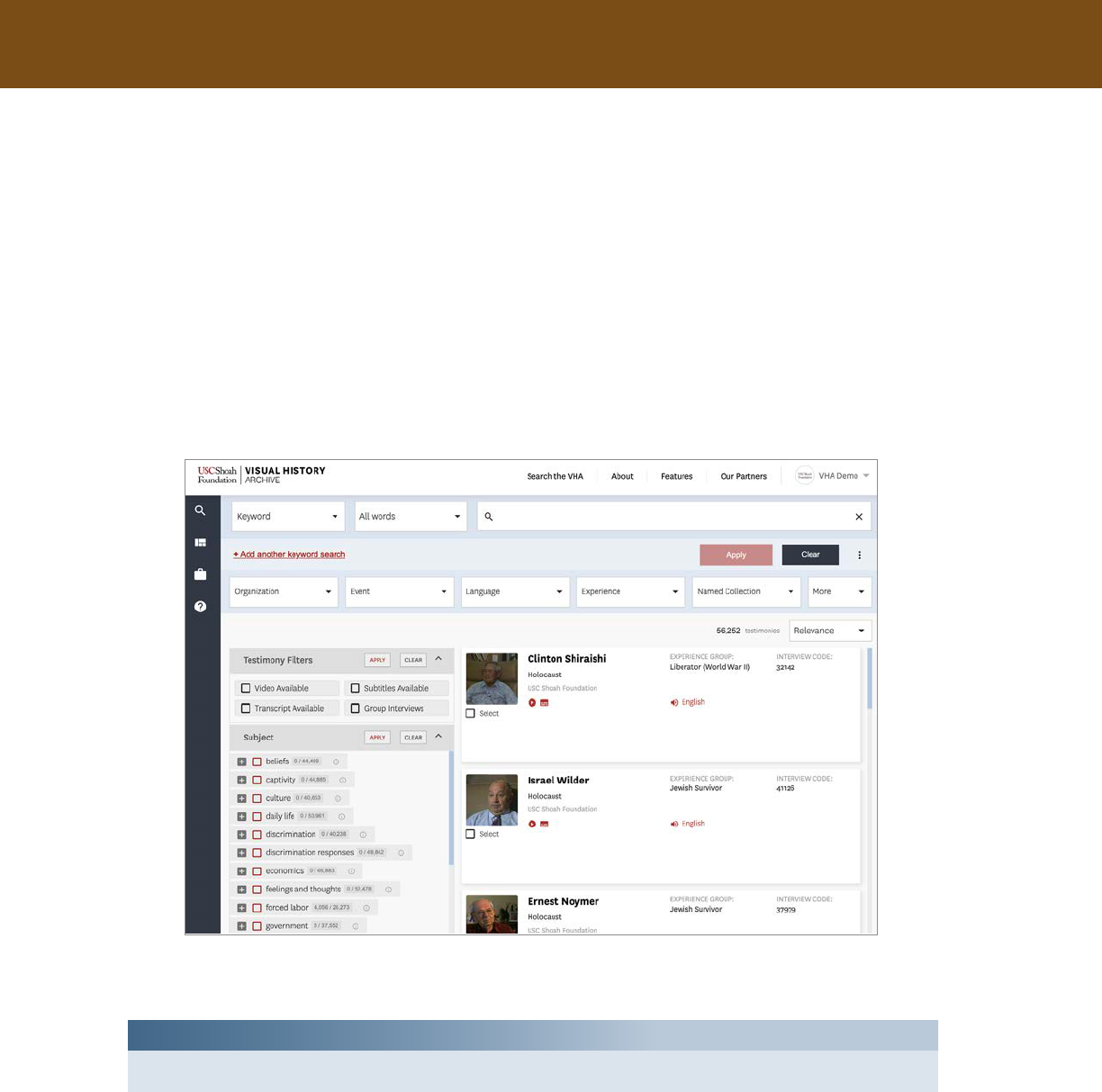
4 | USC Shoah Foundation
Visual History Archive (VHA) User Manual
Search
When logged in, clicking Search or Search the VHA will bring you to the Visual History Archive
search page. All the VHA’s search tools are available in this single workspace, where your search
results will also be displayed without any page refreshing required.
Keyword Search is the default option. You can enter text in the search box and click Apply to
immediately begin to search. is search functions much like a web search engine, and is explained in
detail later on page 22 of this this User Manual. e terms you enter will search for personal names,
indexing terms (and their synonyms) and more.
Clicking Clear will reset your search inputs and search results in their entirety.
AdvAnced SeArch TypeS
When accessing the Visual History Archive on a desktop or laptop, as alternatives to the Keyword
Search, you can select one of the advanced search types available using the dropdown menu that
defaults to Keyword: Subject, Places and People. Brief descriptions of each of the advanced searches
follow:
Note:
The search tools in the Visual History Archive are not case-sensitive.
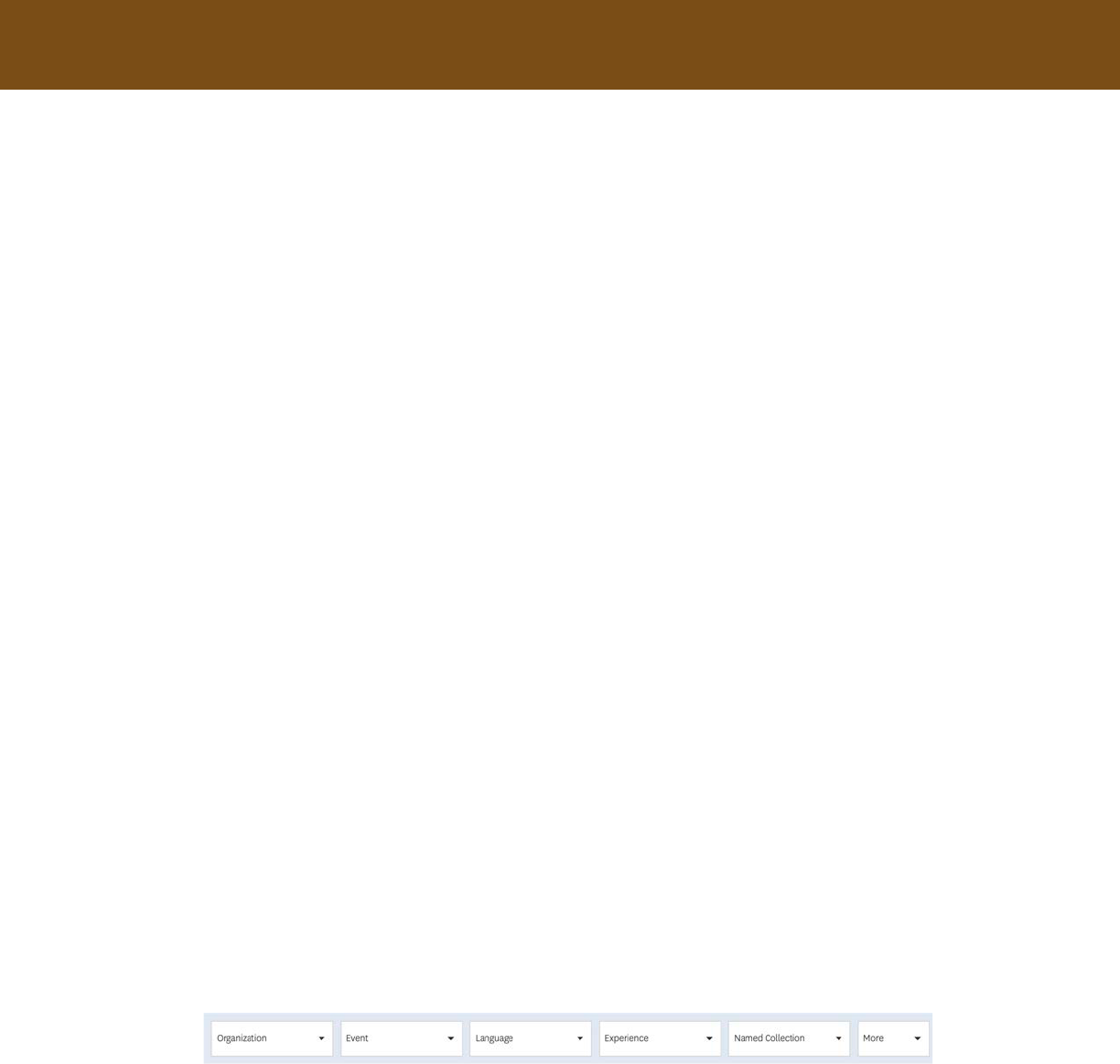
USC Shoah Foundation | 5
Visual History Archive (VHA) User Manual
Subject Search (explained on page 25) exclusively seeks testimony content that references specic
indexing terms from the Visual History Archive. is is the only search that allows users to conduct
their search by combining more than one indexing term, such as “antisemitism” and “schools,” to locate
segments in testimonies in which these terms are discussed in proximity to each other.
Places Search (explained on page 29) allows you to search for segments of testimonies that discuss
specic geographic locations, oering conventional search bar and ltering tools, as well as the option
to draw a region of research interest onto a Google Map to see all segments that discuss a site within
the specied region.
People Search (explained on page 34) allows you to search for a specic name among all names
associated with the testimonies. Names that are searchable include: interviewees, interviewers, names
that were recorded in pre-interview questionnaires that interviewees submitted prior to lming and
names of individuals who were mentioned during the interviews.
FilTering
e search lters in the Visual History Archive will help users reduce unmanageable quantities of
search results. ey can also be utilized instead of inputted search terms; activating a series of search
lters and then clicking Apply without any text in the search bar may be a very viable approach,
depending on a user’s research goals and the specicity of their ltering.
Some ltering options are unique to the various search types listed above; others are accessible
in all searches conducted on the VHA. is portion of the User Manual introduces only the ltering
tools that are persistent across all VHA search types.
dropdown FilTerS
Directly under the VHA search bar are six dropdown menus, each of which oers a lter. Each
of these can serve as a starting point for building a search (e.g., generating a selection of testimonies
based on a collecting partner organization, or based on the interviewees’ biographical data, such as
female survivors from Poland born in the 1920s.
e Organization lter shows testimonies that were collected by the organization(s) selected by
the user. You can read about all of the partner organizations which provided testimony to the VHA in
the Our Partners page, accessible in the top navigation bar.
Filtering by Event reduces results to only show testimonies related to the selected historical
instance of genocide or mass atrocity. Unless this lter is set, the VHA will search testimonies from
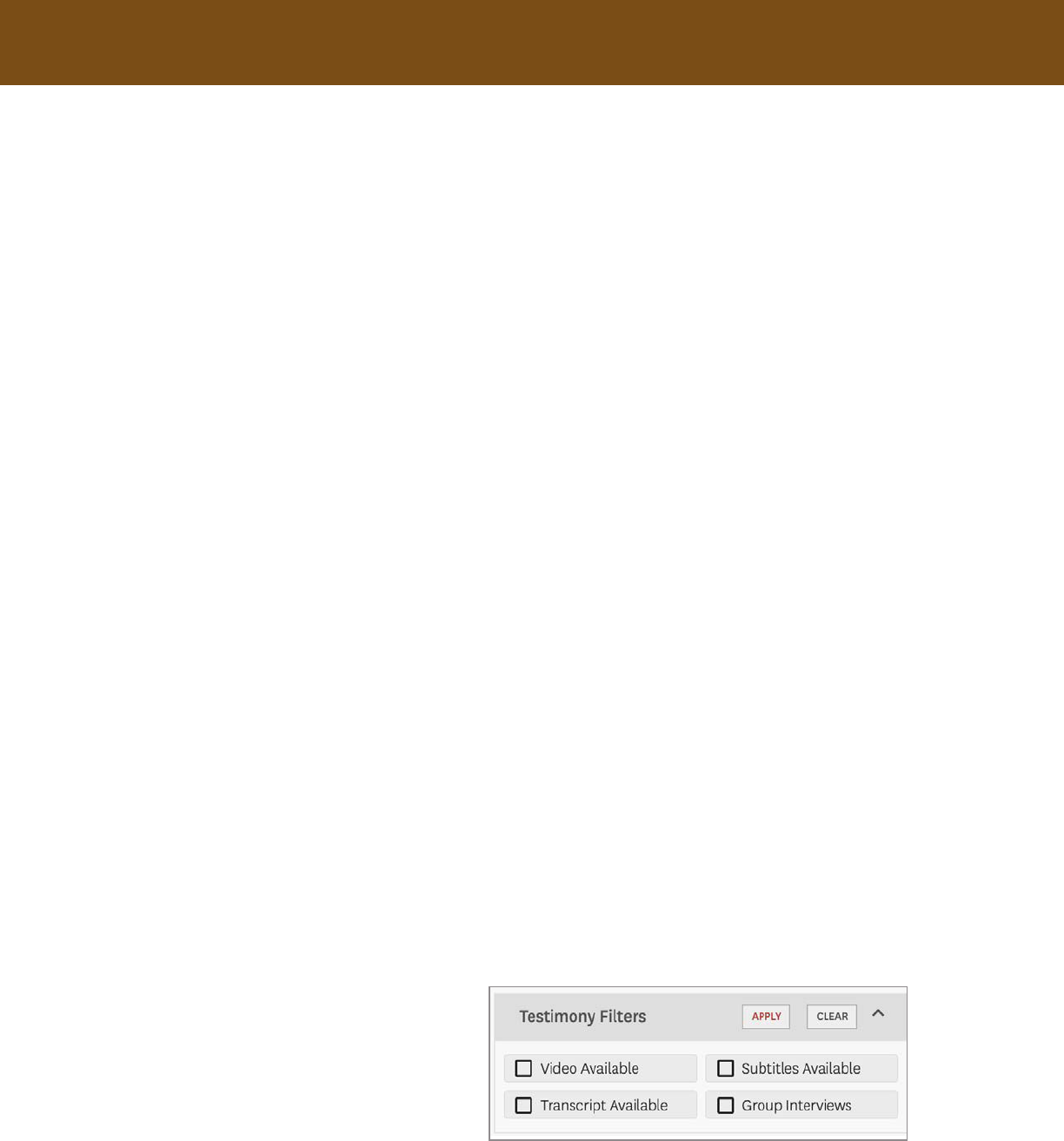
6 | USC Shoah Foundation
Visual History Archive (VHA) User Manual
interviewees who survived or witnessed any of the events discussed in the full archive.
e Language lter allows users to focus their results to show only interviews conducted in the
chosen language. is lter does not interact with translated subtitles; a Mandarin-language testimony
with English subtitles will not display for a user who lters language to just English.
Experience will lter only specic Experience Groups within the VHA. All VHA testimonies
are categorized into specic Experience Groups that reect the interviewee’s relationship with the
particular event they survived or witnessed. Some examples include: Jewish Survivor, Rohingya
Survivor, War Crimes Trial Participant, Rescuer (1994 Genocide against the Tutsi in Rwanda). If a
user checks any of the Experience Groups under this lter, only results from testimonies matching the
indicated Experience Group(s) will display.
e Named Collection lter displays only testimonies that are available in the VHA thanks to a
specic naming donation. ese are grouped into specic collections, searchable through this lter.
Within the More dropdown, users can lter by a variety of additional key biographical details
connected to each interviewee. ese include: Gender, Birth (date and place) and Interview (date,
place, interviewer, length of testimony).
leFT SidebAr FilTerS
Extensive search ltering options are available in the left sidebar of the Search page. All of these
can be independently applied and cleared with their individual associated Apply and Clear buttons.
In specic advanced search types, some additional lters appear in the left sidebar alongside those
described in this section, but Testimony Filters, Subject, Place, Time and Image lters are all included
regardless of what kind of search you are conducting.
TeSTimony FilTerS
At the top of this sidebar, the Testimony Filters section lters out testimony based on variation in
structure and medium.
Video Available presents all results which
oer video to the current user. ere are two
reasons why Video Available would exclude
a testimony: 1) the testimony is audio-only;
2) the user is accessing the Visual History
Archive from an online connection not
aliated with an Access Site.
Applying the Subtitles Available lter will show only testimonies that include subtitles, regardless
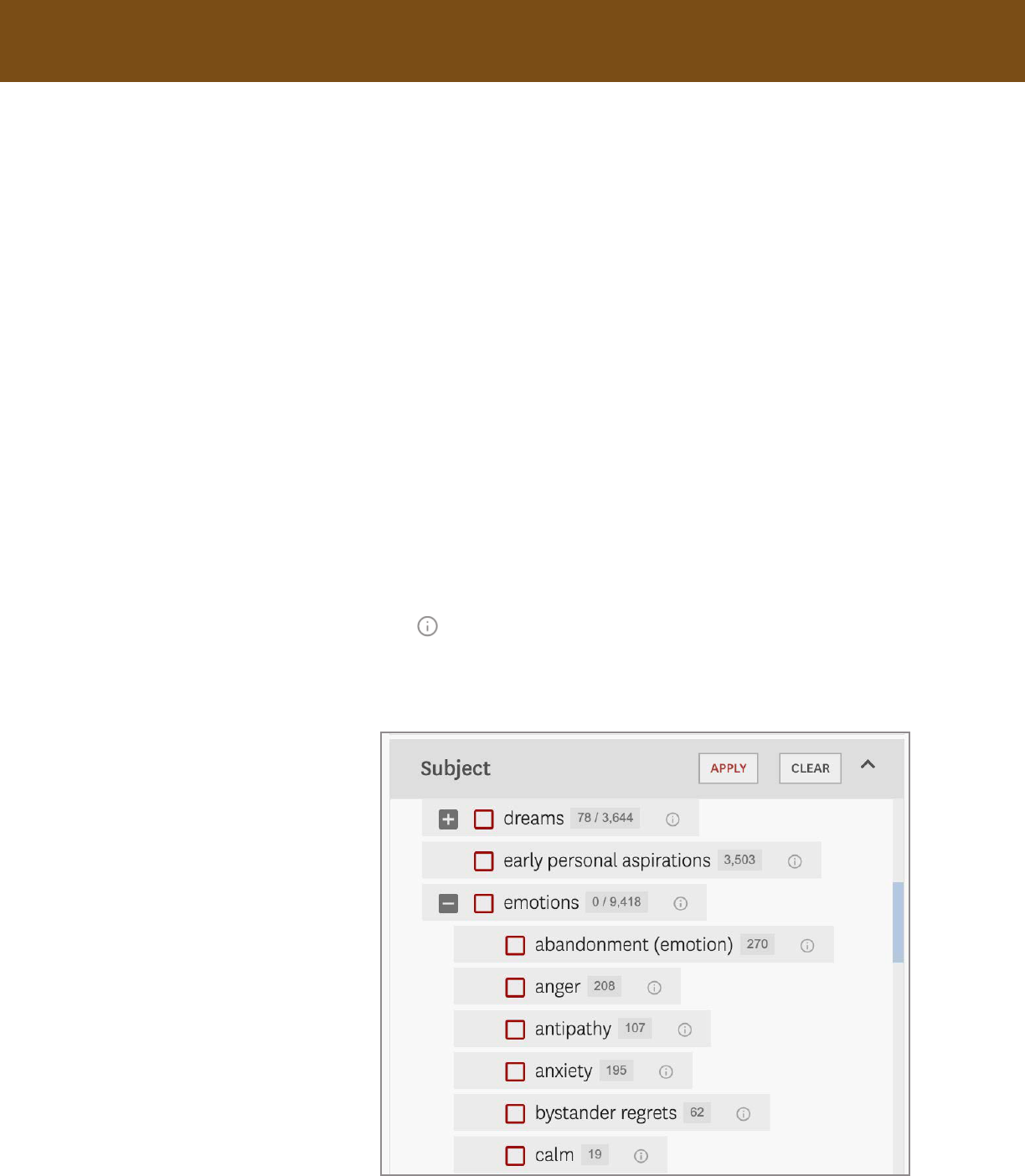
USC Shoah Foundation | 7
Visual History Archive (VHA) User Manual
of the language of the subtitles.
e Transcript Available lter is only available when at a VHA Access Site, as testimony
transcripts are only available at Access Sites. When this lter is checked, only testimonies with
transcripts included will be shown among results.
Filtering for Group Interviews will show only results from testimonies in which more than one
individual was interviewed.
indexing Term FilTerS
Beneath Testimony Filters on the left sidebar are a series of ltering menus (Subject, Place, Time
and Image) that allow users to customize results based on specic terms within the Visual History
Archive’s indexing thesaurus. ese lters focus results by showing testimonies in which a specic
term is indexed; they do not currently lter to the specic segment in which the term is indexed.
ese ltering menus are based on the organizational topic trees of the VHA index. As a result,
there are many categories on the broader levels of the organizational topic hierarchy that are not, in
fact, indexing terms themselves.
At any time, a user can click the icon beside a particular term to read its denition in the VHA
glossary.
Compare “dreams” with “emotions,” from the VHA’s Subject lter.
“Dreams” is both a
parent of other indexing
terms, and an indexing
term itself. “Emotions” is
only a parent category. e
numbers beside each term
contextualize this.
e left number shows
how many testimonies
reference this specic
indexing term (78
testimonies reference the
term “dreams”; 0 reference
the term “emotions,”
because “emotions” is not
an indexing term). e
right number indicates how
many testimonies reference
indexing terms that are
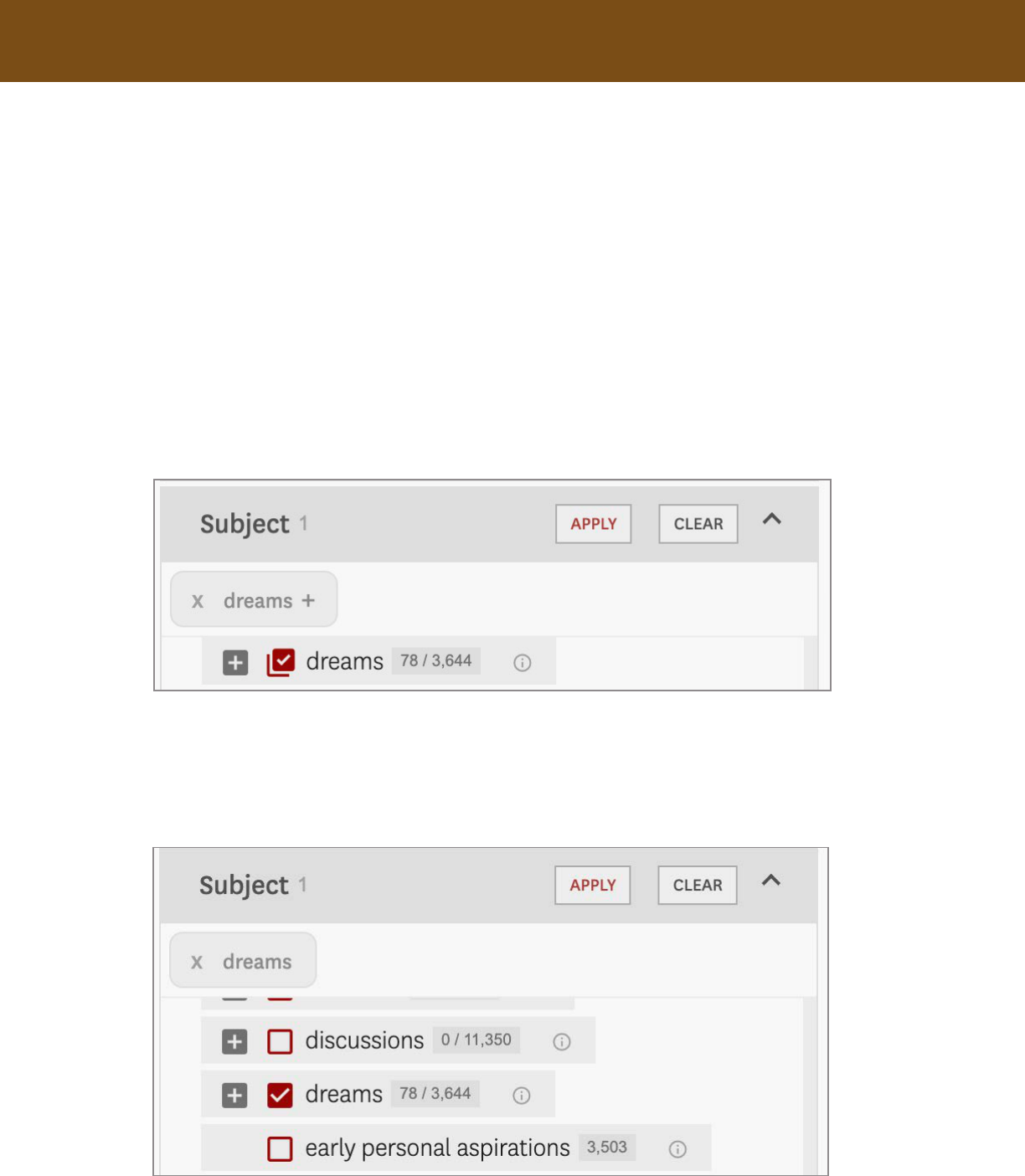
8 | USC Shoah Foundation
Visual History Archive (VHA) User Manual
the children of these parent terms. So if we combined all the children terms of “dreams,” we would
see 3,644 testimonies that reference these; if we did this for the children terms of “emotions,” there
would be 9,418 testimonies in our search results.
With this dynamic in mind, the system for indicating which terms a user want to lter for was
designed to accommodate for terms that may or may not be both parent categories and indexing
terms in and of themselves.
Upon rst checking the box for a parent term, a “double-check” icon will appear, and the term will
be displayed with a plus beside it above. is indicates, as in the example below, that the user intends
to search for both the term “dreams” and all the children beneath it on the topic tree. With a double-
check/plus lter applied to “dreams,” the user could expect the results indicated by the number on the
right beside “dreams”—3,644—because both parent and children are being searched for.
Checking the box a second time would turn this into a lter exclusive to the parent term,
indicated by a “single-check” icon, without a plus beside the term in the list above. In the example
below, the user would be ltering only to testimonies in which the specic term “dreams” is indexed.
is user would expect to see 78 results, because this is the number of results specic to that term.
e Subject

USC Shoah Foundation | 9
Visual History Archive (VHA) User Manual
e four lter categories track indexing terms based on the following organizational structure:
Terms under the Subject lter relate to subject matter discussed verbally in the interview that
are not places, people or time periods. Subject terms can be very general (“early personal aspirations,”
“citizenship”) or very specic (“Soviet psychiatric hospitals”). Some Subject terms may overlap
somewhat with the other categories: “Transnistria,” for example, appears as both a Subject term
(under parent category “government”) and as a Place term.
e Place lter reduces results based on specic indexed locations. Parent terms include both
continents and regions (“Africa,” “Ottoman Empire [historical]”) and geographic features (“forests,”
“swamps”). Indexed Place terms generally reference one or more of their parent terms in their names
(e.g., the indexing term “Kampot [Cambodia : Province]”).
Indexed terms in the Time category generally specify a place as well as time: a specic moment or
era within a specic location. ese dates are usually aligned to specic historical events: for example,
“United States 1933 (March 14) - 1939 (August 31)” was chosen to indicate the dates between
Franklin D. Roosevelt’s presidential inauguration on March 14, 1933 and the German invasion of
Poland on September 1, 1939. is was, naturally, a particular era in United States history, and in its
relationship with Nazi Germany and the trajectory toward what became the Holocaust.
Image terms indicate depictions of photographs, home video, or lmmaking techniques that
appear in the VHA. ese are grouped into a variety of parent categories based on medium and
subject matter. Many VHA testimonies feature photographs and artifacts presented on camera by the
interviewee; in these testimony segments, image indexing terms appear.
UnderSTAnding SeArch reSUlTS
After applying a search query or lter from the Visual History Archive Search page, the testimony
results in the lower-right portion of the page will update in response to the new conditions.
Several indicators appear on a testimony result card that provide context about the particular
testimony and its features. From the text displayed on the sample card below, we can identify
the interviewee’s name (Niddal El-Jabri), the associated event (contemporary antisemitism), the
organization which collected the testimony (USC Shoah Foundation), their experience group
(contemporary antisemitism interviewee), their interview code (a unique identier number
corresponding to the particular testimony; here, 54456), the language of the interview (English)
and which segments the searched-for subject term (Copenhagen shootings [February 14-15, 2015)
appeared in (segments 5, 12 and 14). We can also view a thumbnail image derived from the interview.
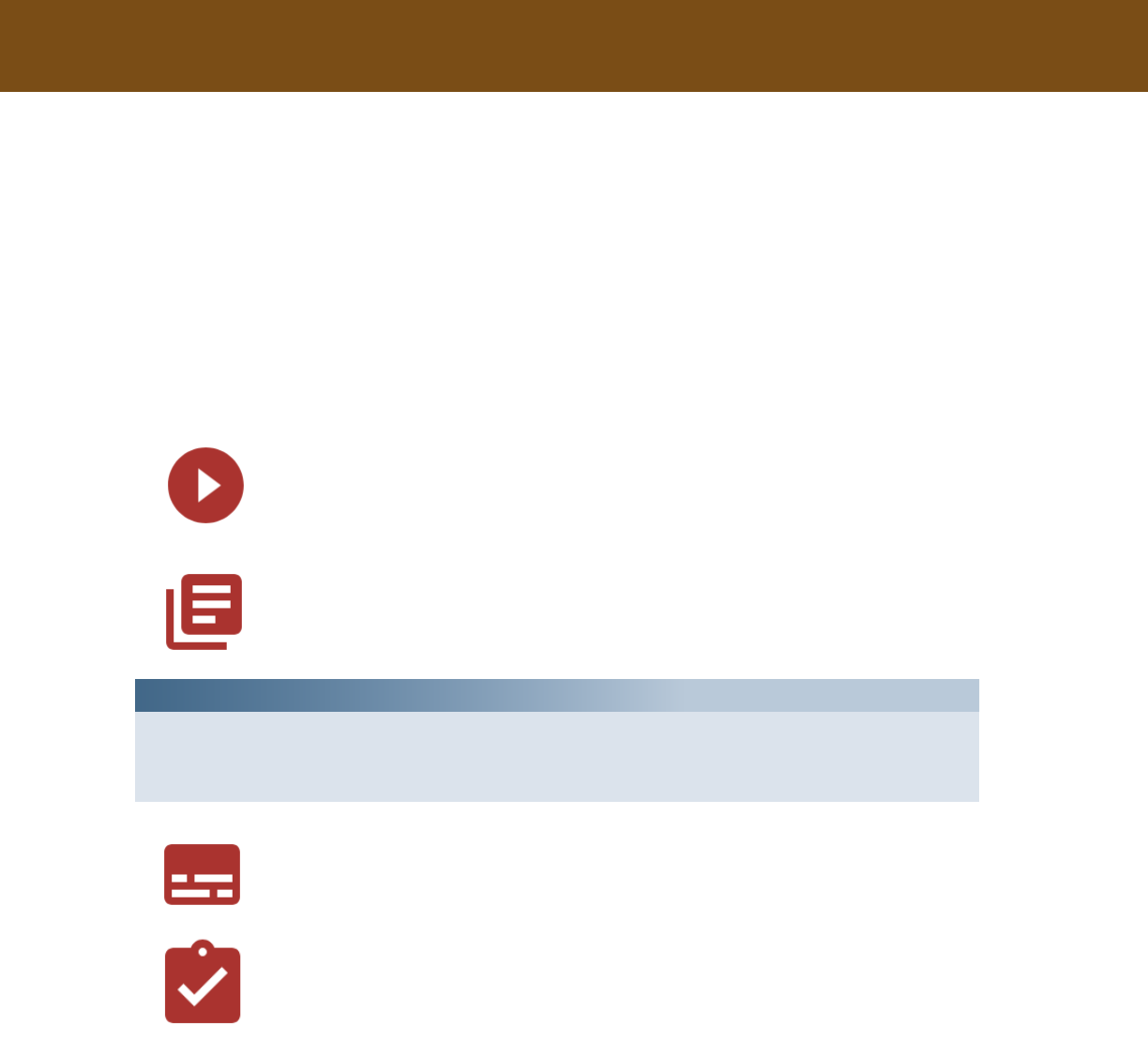
10 | USC Shoah Foundation
Visual History Archive (VHA) User Manual
Clicking anywhere on the card would open the testimony viewing page and initiate playback from
the rst relevant segment (in this case, segment 5; ve minutes into Niddal El-Jabri’s testimony).
Alternatively, clicking on the numbers of the segments themselves will open the testimony
playback from the chosen number—so here, a user could also open the testimony from segments 12 or
14, within which they would also expect to nd references to the Copenhagen shootings.
e icons displayed on the left side of the card all indicate important information, as well. ese
correspond to several of the elements referenced in the Testimony Filters on the left sidebar.
e presence of the video player icon indicates that video of this testimony is
available on the user’s current VHA access pathway. is means that the testimony
is a video testimony, and that the user will be able to watch it on their current
connection.
is transcript icon indicates that the testimony has been transcribed, and that
the user’s current VHA access pathway allows them to view the transcript. is icon
will only appear when a user is accessing the VHA from an Access Site, as transcripts
are inaccessible for online users.
e subtitles icon indicates that the testimony oers subtitles, either in the
original language of the interview, or, in the cases of certain testimonies, translated
from the original language into English.
e audio icon indicates that only audio is available for this particular testimony.
is only appears for testimonies in which no video was ever recorded. It also
indicates that the user will be able to listen to this testimony at their current VHA
access pathway.
Finally, the Select checkbox allows a user to save this particular testimony search result to a
Project in their VHA account. is particular feature is only available for signed-in users, and it is not
available when accessing the VHA on mobile.
SAving SeArcheS And SeArch reSUlTS
Signed-in users of the Visual History Archive can create and add to Projects—explained in detail
further in this User Manual, these allow you to save, organize and share your VHA research.
Note:
ProQuest and USC Shoah Foundation have begun a long-term project to transcribe all testimonies in
the archive. Transcripts will be added to the Visual History Archive as they become available, so
you will see the number of available transcripts grow steadily in the months and years to come.
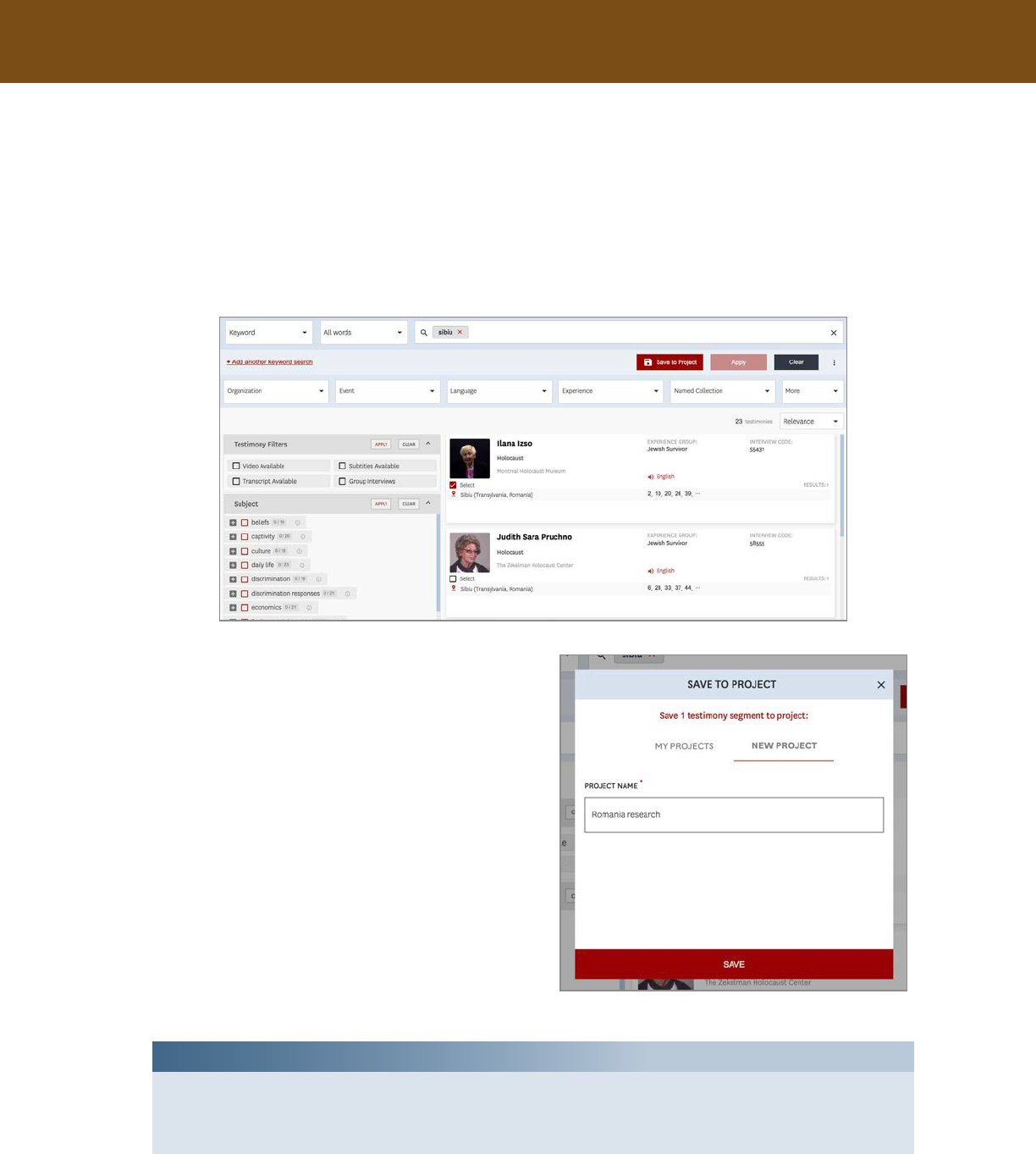
USC Shoah Foundation | 11
Visual History Archive (VHA) User Manual
ree different save functions are available while reviewing VHA search results, all of which
oer distinct and valuable applications:
After you check Select on one or more testimony search results, the Save to Project option will
appear next to the Apply button under the search bar.
Clicking Save to Project will open a pop-up,
in which you’ll be able to either save your selected
testimonies to an existing Project in the My Projects
tab, or—with the New Projects tab—you can
create a new Project and save your selection into it
immediately.
If you want to save all the generated search
results from an applied series of search conditions,
click the vertical ellipsis beside the Apply and Clear
buttons in the search bar, and then click Save search
results. is will also open the Save to Project pop-
up, which will operate the same way as described
above—except all generated search results will be
added to the project upon clicking Save.
Note:
Saving one or more testimony results with the Save to Project button will save the full testimony,
rather than any identified segments. Save search results will, in contrast, itemize each numbered
segment as a separate line in your Project.
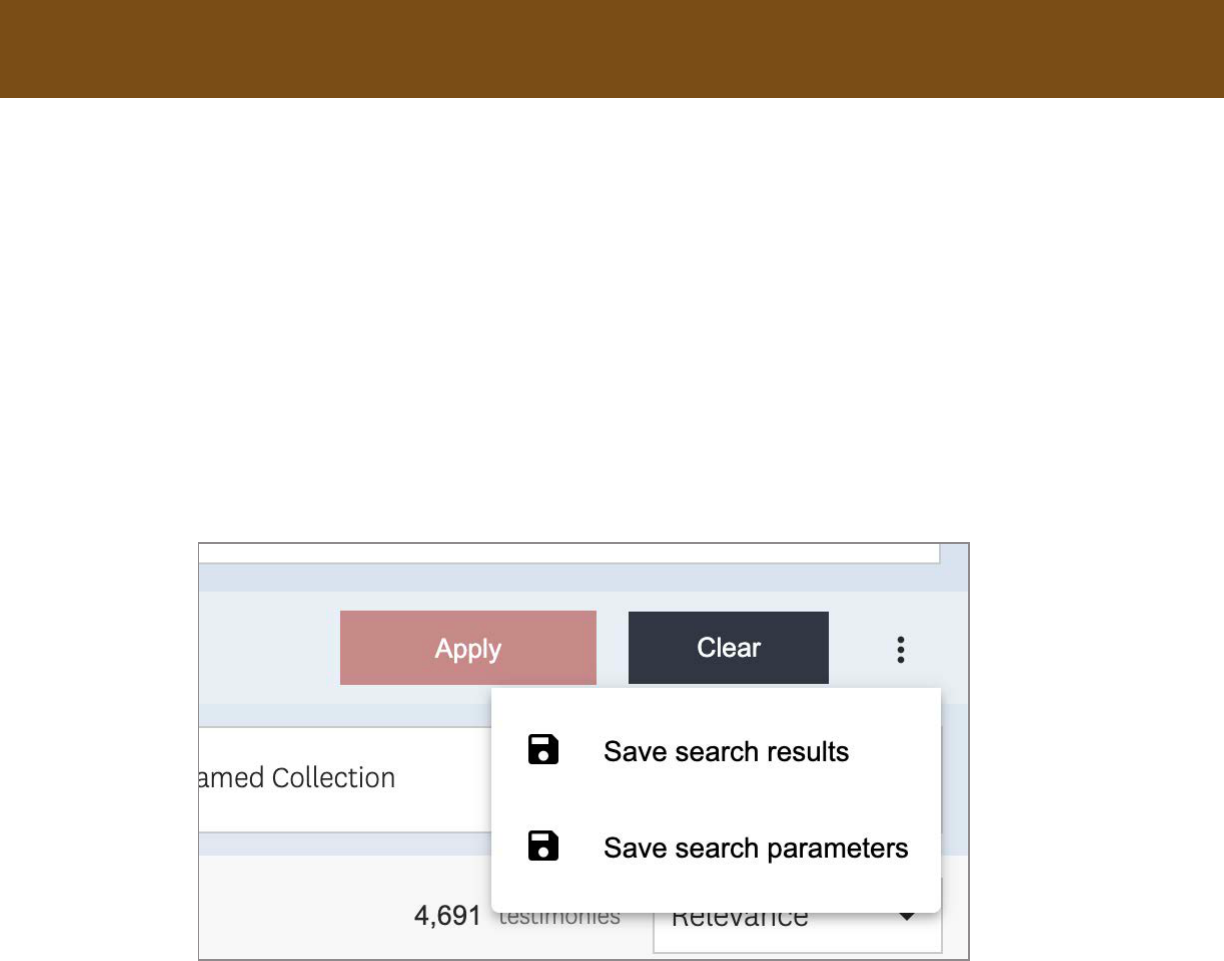
12 | USC Shoah Foundation
Visual History Archive (VHA) User Manual
e third save option from the Search results screen is Save search parameters, which oers the
ability to save the conditions of a particular search, instead of the results themselves. ese will display
dierently in the Projects page, as a tracked search with all terms, lters and other conditions saved,
which you will be able to return to at your discretion in the future through your Project—eliminating
the need for you to conduct the search all over again.
To utilize this function, click the vertical ellipsis and then click Save search parameters. is will
make the Save to Project pop-up window display, with one distinction from the above cases: a Note
free text eld will be present in both the My Projects and New Project tabs, allowing you to write a
short description of the search condition, so that context around the search can be framed alongside
its storage in your Project.
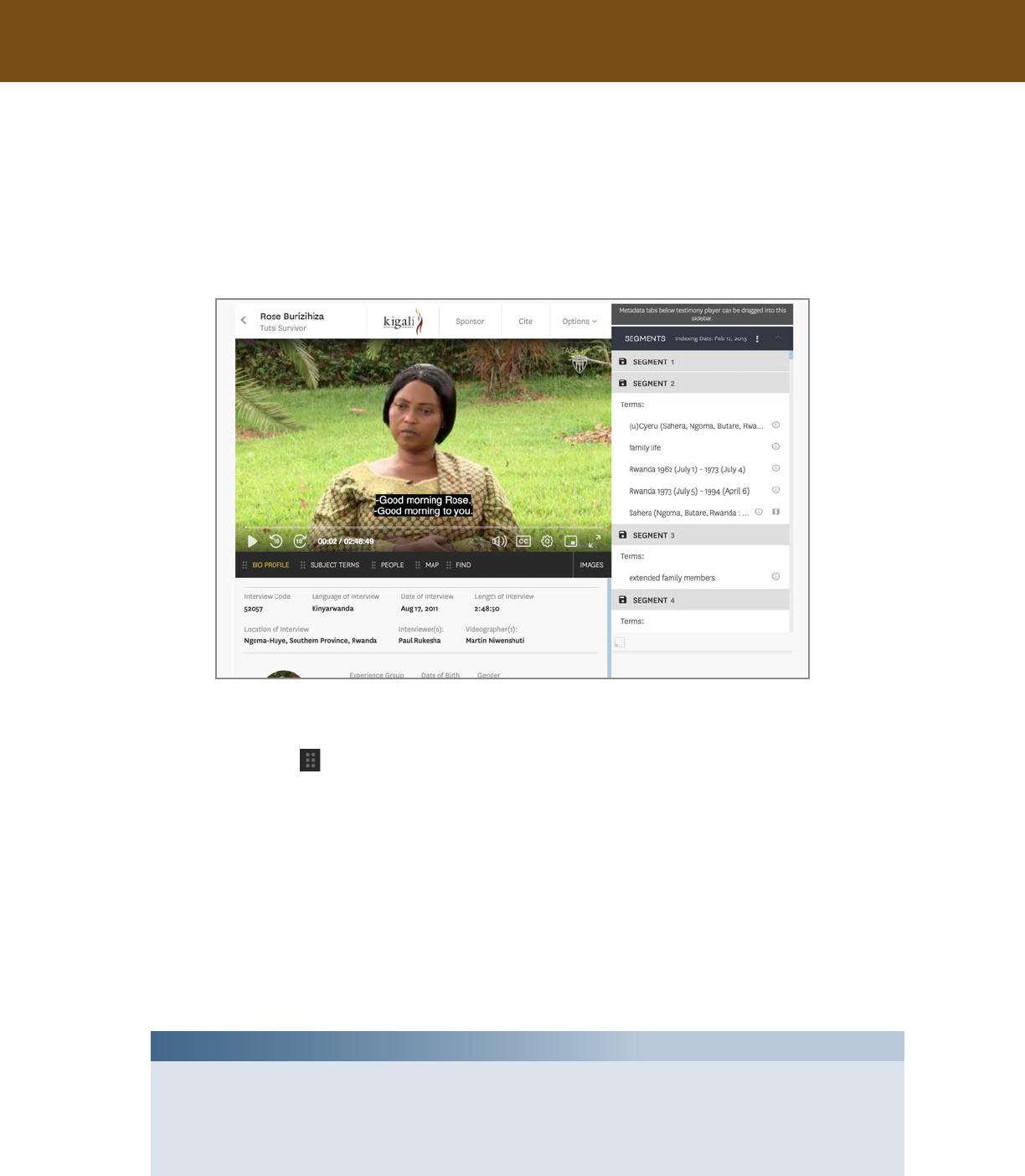
USC Shoah Foundation | 13
Visual History Archive (VHA) User Manual
Testimony Viewing Screen
When viewing testimony in the Visual History Archive, extensive metadata, indexing resources
and navigation tools are available at your ngertips to enrich and ease your experience. If your VHA
access allows you to view a particular testimony, your screen will resemble the layout below.
e testimony viewing screen’s features will be identical regardless of which search type was used.
By clicking the symbol adjacent to any of the metadata tabs below the video player, you can
drag the Bio Prole, Subject Terms, People, Map and Find resources into the right sidebar, and from
the sidebar back into the space below the video player. In this way, VHA users can customize the
testimony viewing screen layout to meet their preferences or moment-to-moment needs.
video plAyer
e video player window itself oers a suite of playback control options, roughly akin to what
users will have encountered on YouTube or other internet video distribution platforms. In addition to
basic scrubbing, the buttons at the bottom of the video player can: advance or rewind in ten-second
increments; adjust volume; turn on or o closed captions and subtitles; alter settings about resolution,
Note:
Many Visual History Archive testimonies were recorded on film. These were usually filmed across
multiple tapes, averaging around thirty minutes each. In a few instances, one or more separate tapes
were added to a testimony after the original filming, as part of a supplementary interview. In contrast,
most more recent testimonies filmed digitally include only one tape of material, with variable length.
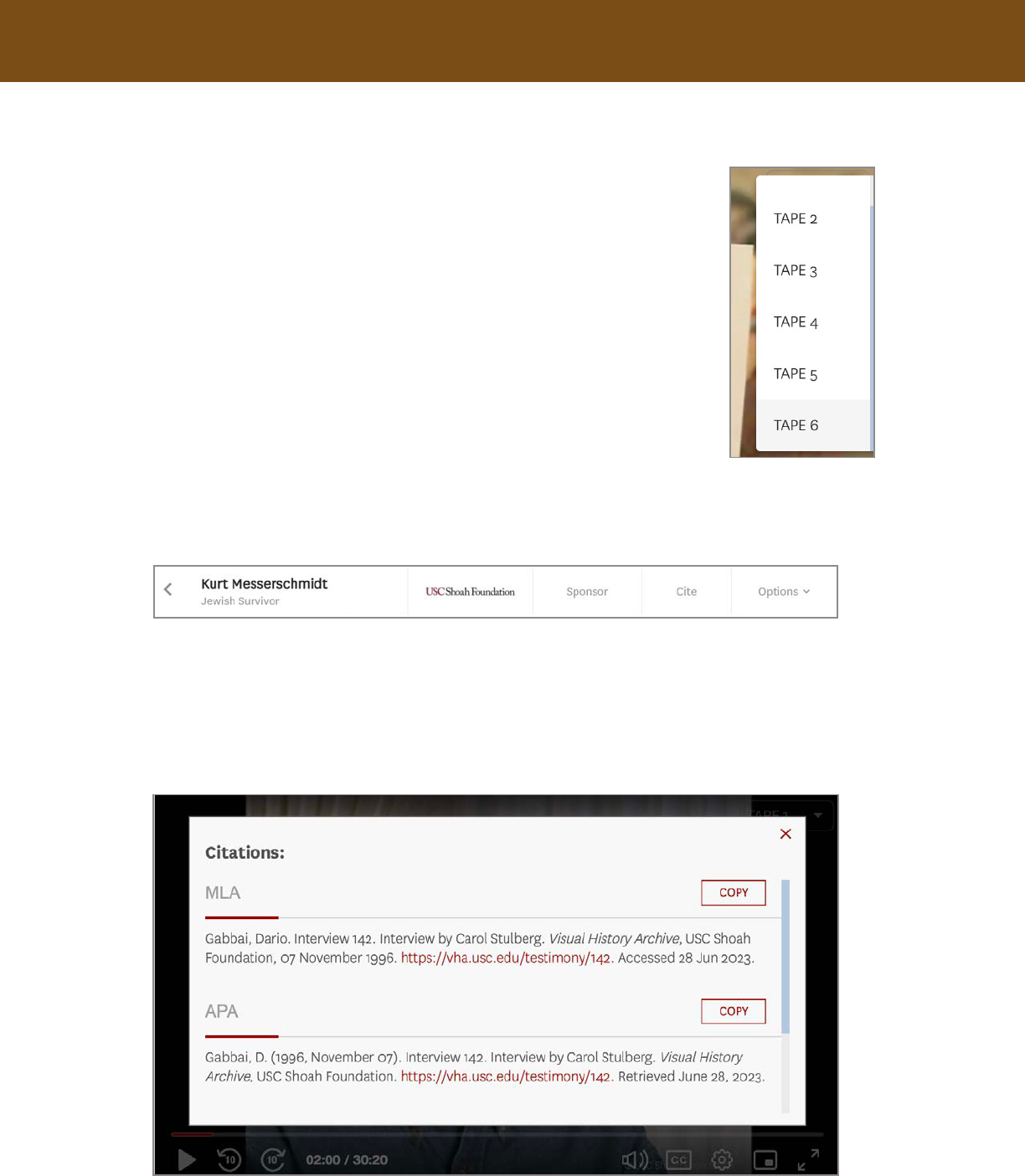
14 | USC Shoah Foundation
Visual History Archive (VHA) User Manual
In the top-right of the player window is a semitransparent dropdown menu
that allows users to navigate the testimony by tape number. is also indicates
the current tape that is being streamed in the player.
provenAnce, ciTATionS And opTionS
e interactive bar directly above the testimony viewer presents context and
additional options for the viewer.
e arrow icon to the left of the interviewee’s name and experience group
is a back button, which will return you to the search page, with the search
parameters that brought you to the currently open testimony pre-loaded.
Directly to the right of the name and experience group is a logo for the organization which
recorded the testimony. Clicking this logo will open the particular organization’s Partner page within
the Visual History Archive’s Our Partners section.
Clicking Sponsor will open a small pop-up window over the video player, sharing specic context
for how this testimony’s recording, preservation and/or indexing were funded.
e Cite button opens a pop-up presenting pre-constructed citations for the particular testimony
and date, in MLA, APA and Chicago Manual of Style formats. Click Copy beside any of these to
automatically copy them to your device clipboard.

USC Shoah Foundation | 15
Visual History Archive (VHA) User Manual
Options will open a dropdown menu oering four options: Print, Save, Share and Report Video
Problem.
Pressing Print here will open a new tab, presenting metadata about the interview in a printable
format. Biographical prole information is a xed component of this page; users can also check or
uncheck segments, subject terms and people metadata to, respectively, include or remove them from the
printable content. If a transcript is available for a testimony, and if your Visual History Archive access
enables transcript viewing, you will also be given the option to show and print the transcript here.
e Save button in Options allows a logged-in user to save a testimony to their projects, much
like the Save to Project function in the search results screen.
Clicking Share presents an overlay above the testimony player, enabling quick share functions
to distribute links to the testimony over Facebook, Twitter and the user’s default email client.
Additionally, from here, a custom link can be copied to the user’s clipboard that will lead to the
particular second of the testimony that is currently playing or paused.
Report Video Problem opens a pop-up form through which users can contact USC Shoah
Foundation about technical issues they may nd with a particular testimony, so any challenges or
oversights can be resolved as promptly and eectively as possible.
SegmenTS And indexing
e Segments sidebar displays segment numbers, along with indexing terms and names of people
who were associated with those segments during the indexing process. Some segments have no
assigned indexing terms because a topic may not have been discussed in sucient detail, or, when the
discussion spans several segments, the relevant indexing terms have been applied only once near the
beginning of the discussion.
Most segments in the Visual History Archive span exactly one minute in video length. Early
in USC Shoah Foundation’s indexing history, segment beginnings and endings were determined by
indexers, who tried to align these to stories told in the testimony. is approach was abandoned and
replaced with universal one-minute segments.
is sidebar will auto-scroll in accordance with the viewer’s progress with the testimony, unless
the user clicks the vertical ellipsis and deactivates Auto Scroll.
As pictured to the right, placing a mouse cursor over an indexing term, in this case Rohingya
persecution awareness, activates the thesaurus denition pop-up window for that term. Clicking the
icon will open a full term definition, and the icon will show a location on a map.
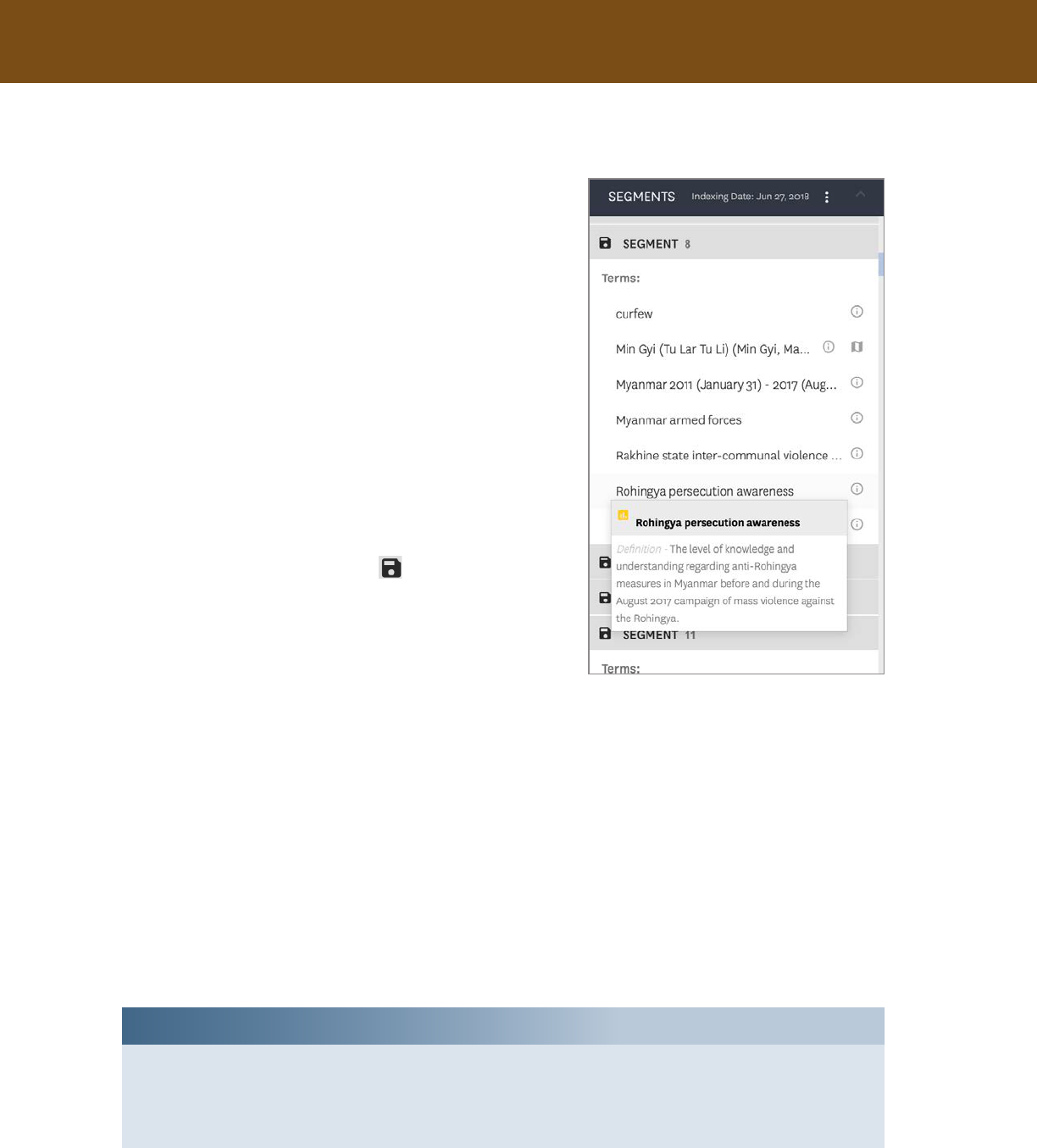
16 | USC Shoah Foundation
Visual History Archive (VHA) User Manual
To view the segment of video when a particular topic is
discussed in the interview, click the segment number that
contains the relevant indexing term. For example, clicking
Segment 8 on the right shifts playback to this segment in
the interview, where the interviewee discusses Rohingya
persecution awareness (and the other terms indexed here).
SAving A SegmenT To A projecT
If you would like to save a specic segment to a project
while watching testimony, click on the icon next to the
segment number. is will display the Save to Project
window, and allow you to save the segment to either an
existing project or a new one. Saving segments in this way
can be particularly useful to keep track of specic relevant
testimony clips for a research question.
biogrAphicAl proFile
e Biographical Prole (onscreen as Bio Prole) defaults to appear below the testimony video
player upon opening the testimony viewing page, although it can be dragged into an alternate order or
position. is contains basic biographical information about the interviewee that was collected from
the interviewee in a pre-interview questionnaire, as well as from the actual interview. You can scroll
through the displayed data using the up and down arrows on the scroll bar to the right of the window.
Information related to the testimony’s production, such as the Interview Code, Date of Interview,
and the Language of Interview is displayed rst, followed by information more specic to the
interviewee and their experiences.
Note:
Some biographical profile categories are customized for the various events discussed in the Visual
History Archive. So an interviewee who survived or witnessed the Holocaust will show several
different biographical profile categories from someone who survived or witnessed the Cambodian
Genocide.
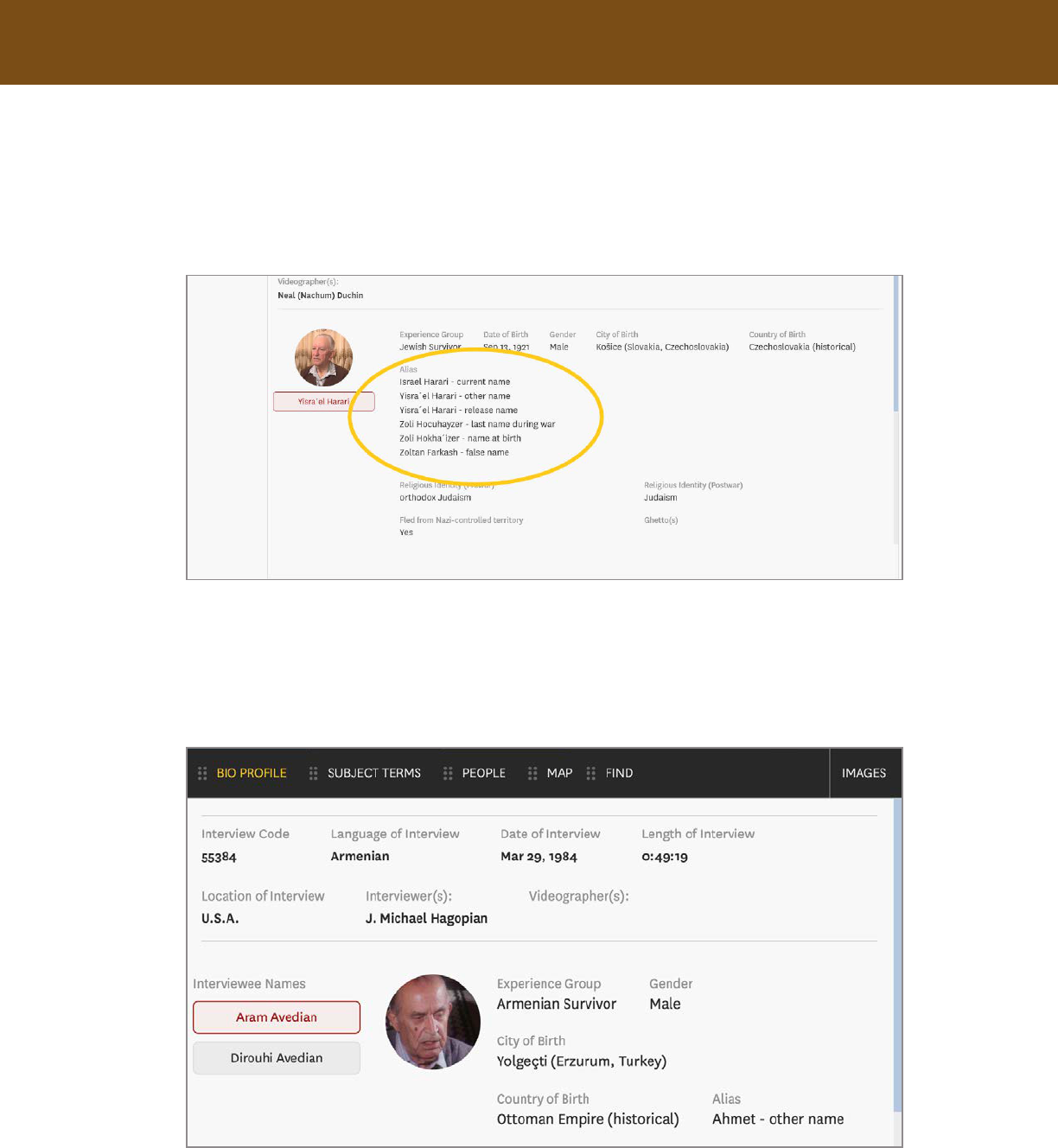
USC Shoah Foundation | 17
Visual History Archive (VHA) User Manual
Because many interviewees used dierent names at dierent times in their lives, many testimonies
are discoverable under a variety of alias names. All aliases for a particular interviewee are included in
the biographical prole as well, as shown in the example below.
In Group Interviews, separate Biographical Prole sets are available—one for each individual
interviewed in the testimony. Click each individual’s name to view their respective prole. Below,
Aram Avedian’s prole is displaying, as indicated by the red highlighting; clicking Dirouhi Avedian
would switch the display to show Dirouhi Avedian’s prole information.
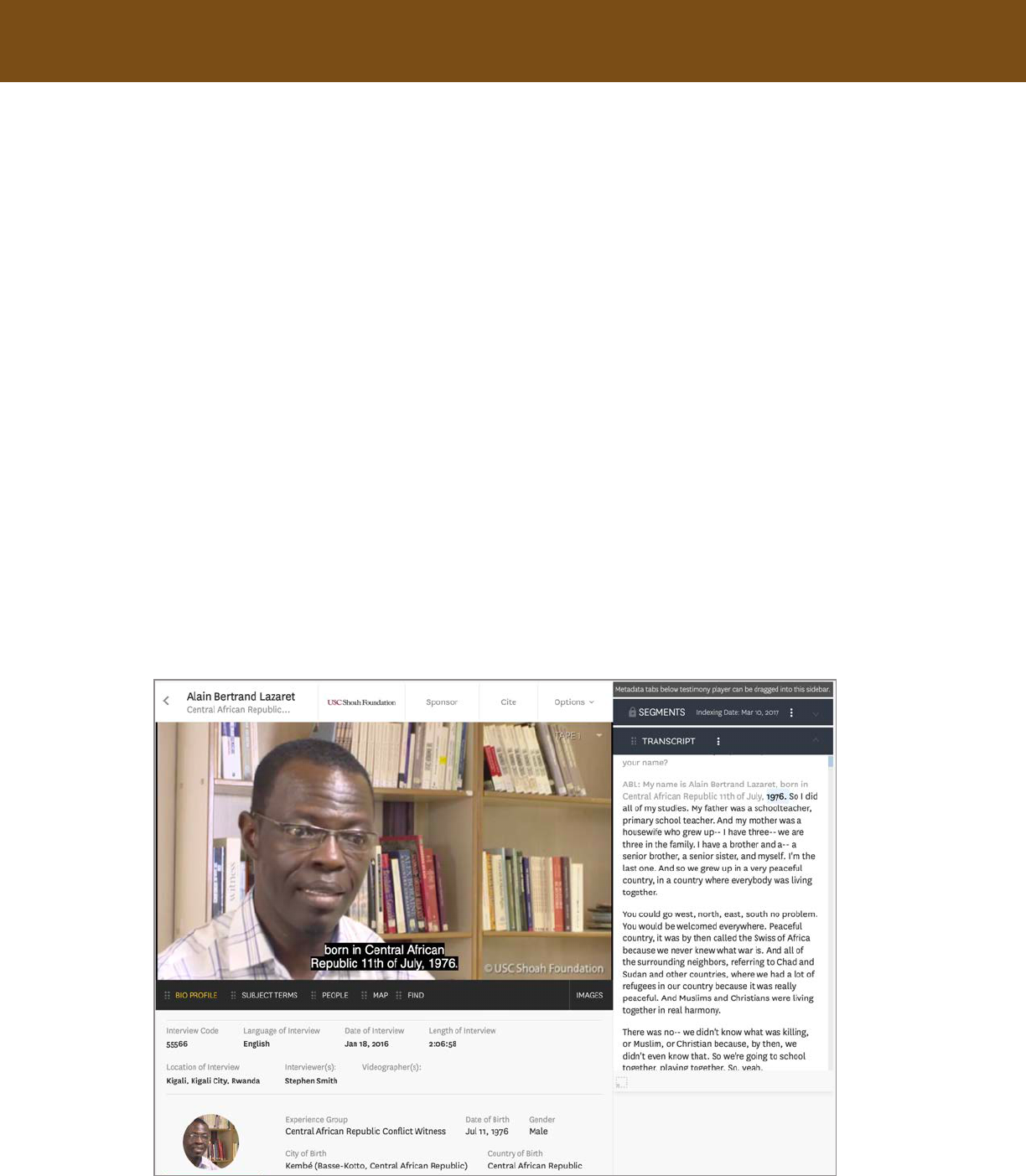
18 | USC Shoah Foundation
Visual History Archive (VHA) User Manual
TrAnScripT
When viewing testimonies with available transcripts at a Visual History Archive Access Site, a
Transcript viewer will be accessible from the testimony viewing screen. If a testimony does not have a
transcript available, or if the testimony is being accessed from public internet, this will not display.
As of July 2023, over 6,300 testimonies in the VHA oer transcripts. is number will continue
to increase over time, through ProQuest and USC Shoah Foundation’s long-term collaborative project
to transcribe all the testimonies in the VHA.
In the example pictured, the transcript appears in the box below the video. Transcript Auto Scroll
is checked by default, so the words being spoken will be highlighted in blue and will continue to
track what’s spoken in the video as it plays. To deactivate this function, click the vertical ellipsis at the
top of the Transcript viewer and turn o Auto Scroll.
Additionally, clicking a particular word in the transcript will automatically shift the playback
point of the video player to the approximate moment when that word is spoken.
Each testimony with a transcript will have closed captions available in the language of the
interview that you can turn on by clicking on the CC icon (“closed caption”) below the video. When
turned on, the closed captions will be displayed across the bottom of the video as pictured below and
will track what is spoken.
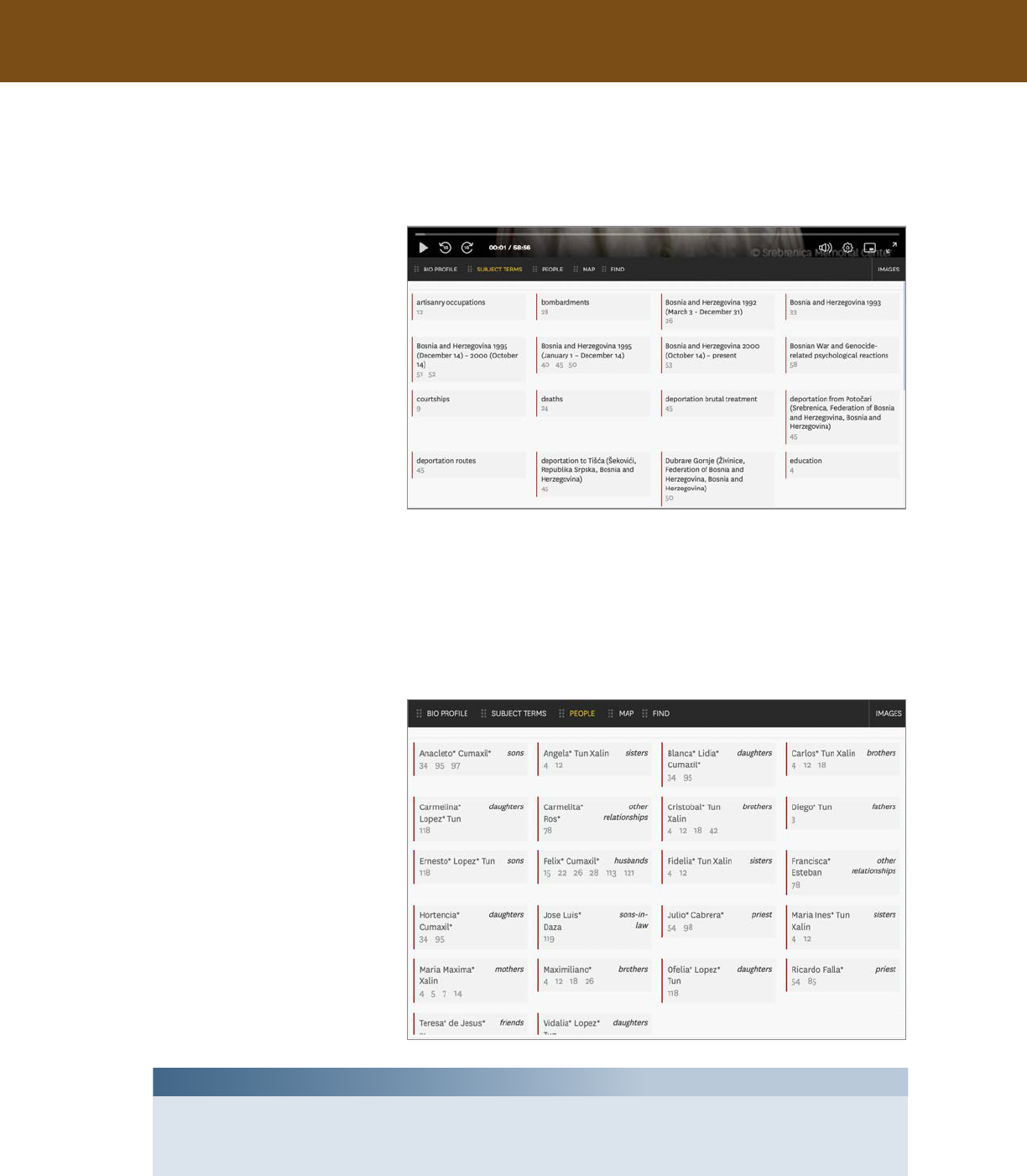
USC Shoah Foundation | 19
Visual History Archive (VHA) User Manual
SUbjecT TermS
By clicking Subject Terms,
you are able to view a list of all
terms indexed in the testimony,
ordered alphabetically, with the
segment numbers in which each
term was indexed as shown to
the right. When you nd an
indexing term of interest, just
click on the segment number
and the video will jump directly
to that segment.
Clicking on Segment 45
here will lead to a segment
discussing deportation routes.
people
When you click on People, you are able to view a list of names of all the people indexed in the
testimony, including each person’s relationship to the interviewee, and the segment number in which
the people are mentioned.
If you would like to view a
segment of a video in which a
particular person is discussed,
just click on the number listed
underneath that person’s name.
For example, clicking on
Segment 4 or 12 will take you to
the segments in the interview
when the interviewee discusses
her sister, Angela* Tun Xalin.
Note:
An asterisk (*) after a name indicates a phonetic spelling. Brackets [] around a name indicate that
it is an assumption; for example, a child’s last name might not be mentioned in a testimony, but it
is likely the same as their parents’ name.
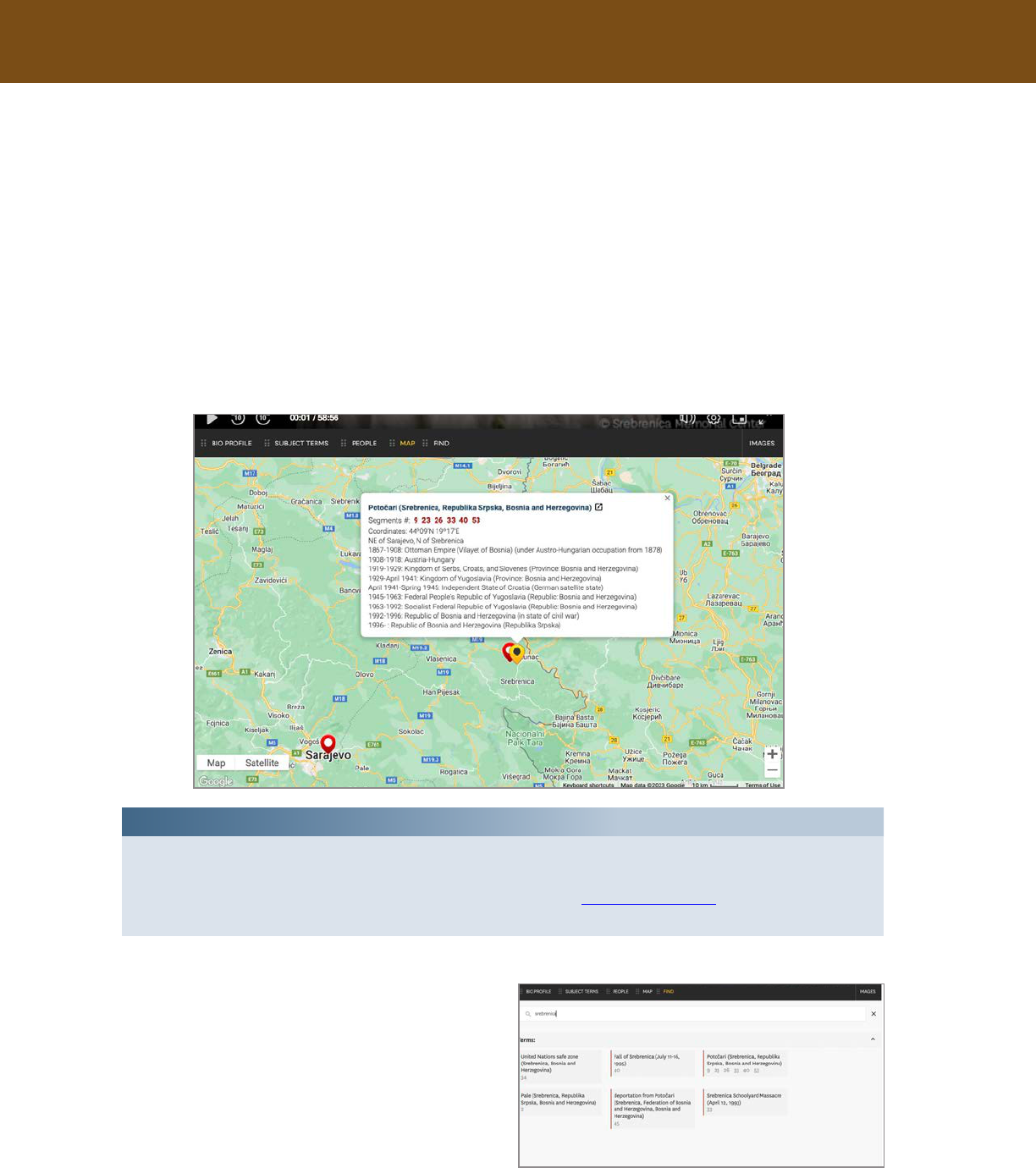
20 | USC Shoah Foundation
Visual History Archive (VHA) User Manual
mAp
You can use the Map metadata tab to view all place terms indexed in the testimony, pinned onto
an interactive Google Map. Clicking on individual map pins will display the Visual History Archive
glossary information about the location, as well as a list of all segments from the open testimony in
which the location is referenced.
Click any of these segments to shift the video player to that portion of the testimony. In the
example below, clicking 9, 23, 26, 33, 40 or 53 would begin playing a segment of Hajrija Orić’s
testimony in which Potočari, Srebrenica is referenced.
Find
Find oers a search bar for all indexing
within the testimony. Enter a topic of interest,
and all terms indexed in the testimony will appear,
accompanied by clickable segment numbers for all
segments in which the term is discussed..
Find also searches the transcript, in all
testimonies for which a transcript is available.
Note:
Not all of the Visual History Archive’s geographic indexing terms have been assigned latitude
and longitude coordinates for map display. Assigning coordinates to the terms remains a work in
progress. If you notice inaccurate coordinates, please email vhahelp@usc.edu to report the issue
so we can review and correct it.
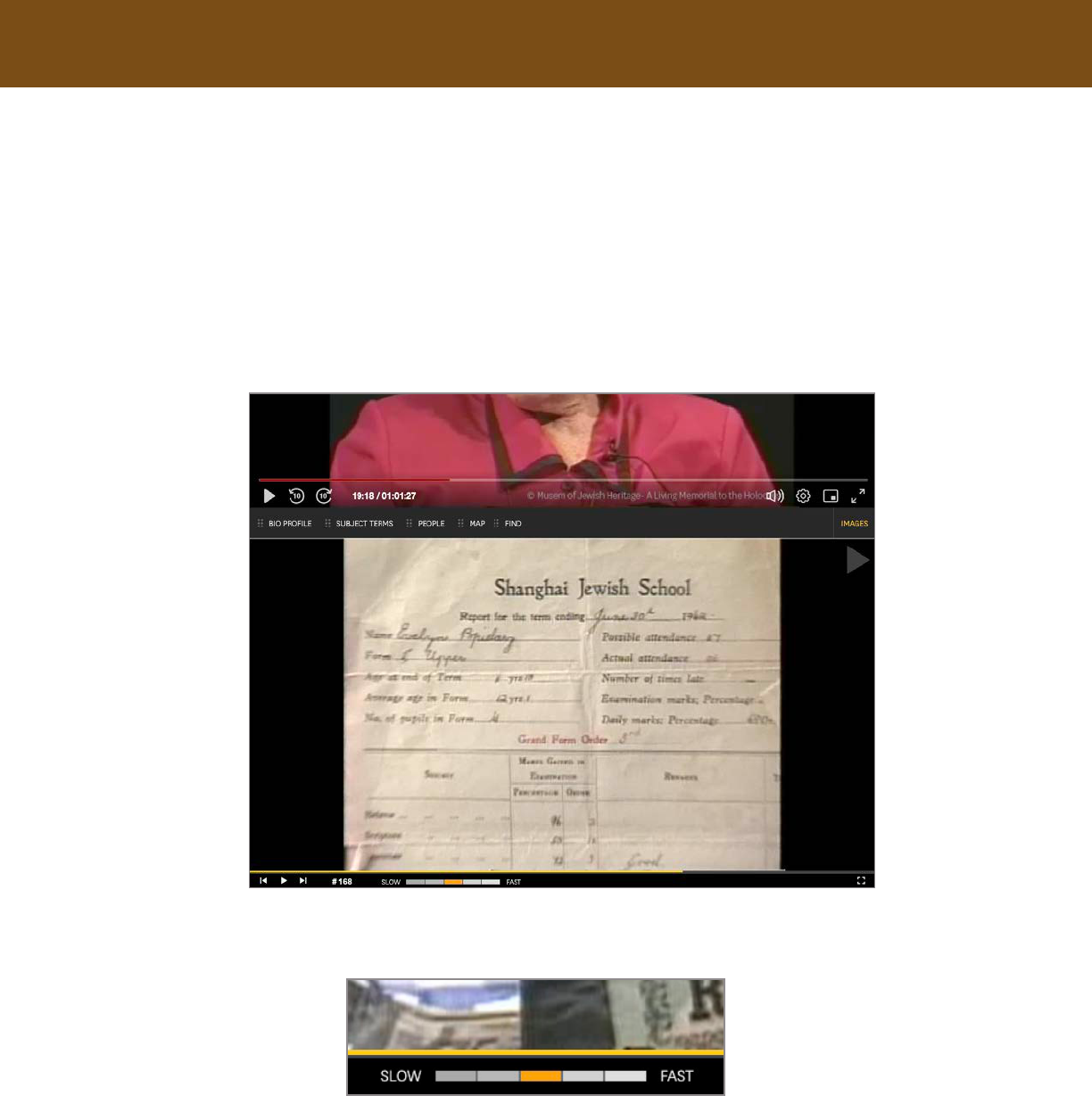
USC Shoah Foundation | 21
Visual History Archive (VHA) User Manual
imAge SlideShow
e Images button, located to the far-right of the metadata tab bar beneath the video player,
opens a slide show of still images from the interview.
Frequently, near the end of the interview, interviewees presented family photographs, documents,
and artifacts from the prewar, wartime, and postwar periods to be videotaped. Still images extracted
from the video of these items are presented in the Image Slideshow.
e slideshow will advance on its own unless the Pause icon is clicked. Dragging the yellow box
in the Slow-Fast slider will adjust the rate of auto-advance.
e arrows to the left and right of the Play/Pause button will reverse or advance the slideshow by
one image, respectively.
Clicking the fullscreen button in the bottom-right will ll your screen with the slideshow.
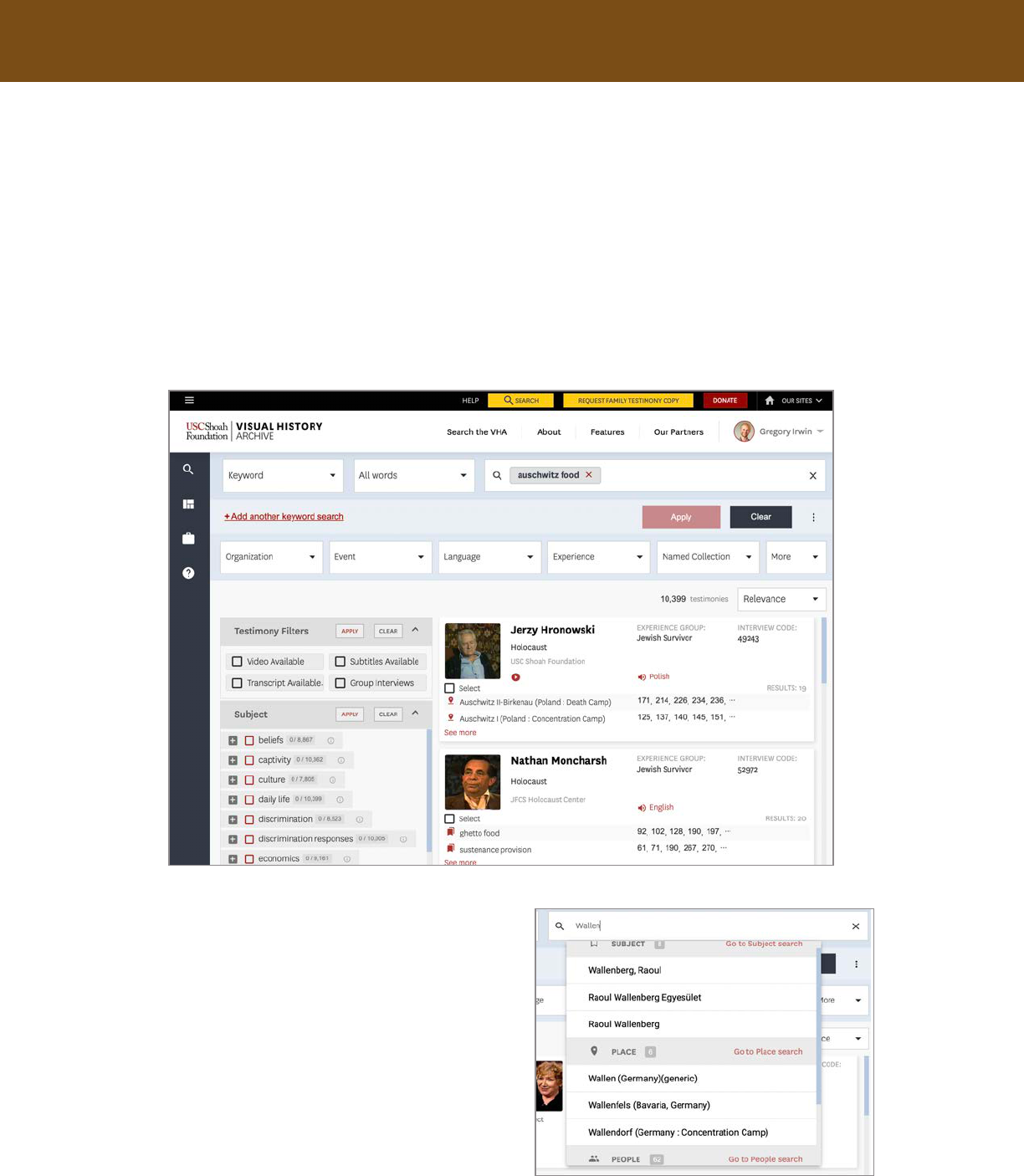
22 | USC Shoah Foundation
Visual History Archive (VHA) User Manual
Keyword Search
Your default search option in the Visual History Archive is Keyword Search, which is designed to
be exible, intelligent, and accessible—combining elements of all the other search options available in
the VHA. Keyword Search seeks with the VHA’s curated keywords to derive results related to any free
text you submit, and will show any related testimony segments the search yields. It also utilizes other
metadata available in the archive, including biographical prole data.
Keyword Search is currently the only VHA search option usable on mobile devices.
While you input your search, Keyword Search
will display up to three auto-suggested terms in each
of the three advanced search types—Subject, Place
and/or People Search—based on the text you have
entered so far. Click a suggested term located in the
Subject, Place or People categories will take you to
that specic search. To remain in the Keyword Search,
click Apply or press Enter/Return on your keyboard.
Learn more about these three search options in
their corresponding sections, available further in this
User Manual.

USC Shoah Foundation | 23
Visual History Archive (VHA) User Manual
FocUSing yoUr Keyword SeArch
Select the desired search type using the dropdown menu for All Words, Any Words or Exact
Phrase, located to the left of the search box. e search type defaults to All Words, so if you enter more
than one term, the Visual History Archive will search for individual testimonies whose associated
indexing data contains all the entered terms. at is, selecting the search type All Words performs an
AND search between the entered terms.
If you select the search type Any Words, the VHA will search for individual testimonies whose
associated indexing data contains any of the words. at is, selecting the search type Any Words
performs an OR search involving the entered terms.
If you select the search type Exact Phrase, the VHA will search for individual testimonies whose
associated indexing data contains the same precise text submitted.
If you click Add another keyword search, you will have the opportunity to combine your initial
search with another, which can incorporate its own individualized All Words, Any Words or Exact
Phrase search type. is functionality also presents the user with And, Or and Not search conditioning
options for the additional keyword search(es). Up to ve separate keyword searches can be combined.
Keyword Search integrates all of the ltering options described in the Search Overview section of
this user manual. At any time, you may adjust your search results using any of the lters onscreen, and
then subsequently clicking Apply to implement your altered search parameters.
Keyword SeArch exAmple: whAT iS AvAilAble in The viSUAl hiSTory
Archive AboUT UKrAine?
If seeking a general understanding about what content related to Ukraine is available in the
Visual History Archive, the breadth oered by Keyword Search would present the best opportunity to
retrieve the most comprehensive possible overview.
For this question, the user could begin by typing “ukraine” into the search bar and clicking Apply
(or pressing Enter on their keyboard), without clicking on any of the suggested search terms. Clicking
a suggested search term would instead send the user to a focused Subject, Place, or People search for
the selected term.
Note:
Depending on the terms you enter in the Keyword Search, your search may return more results
than are easily managed, or it may yield no results at all. All Words or Exact Phrase will help limit
your search; Any Words can help broaden it.
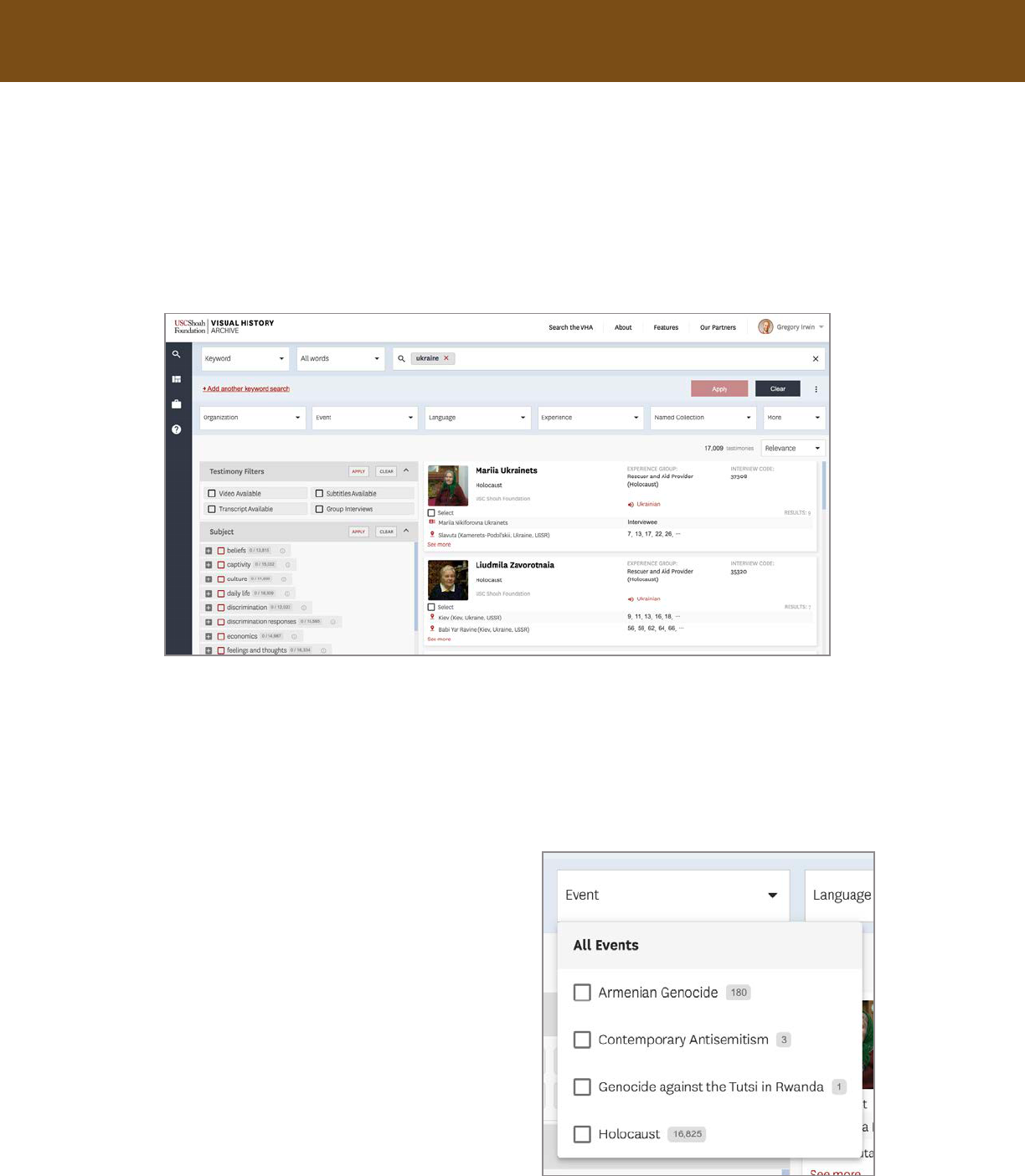
24 | USC Shoah Foundation
Visual History Archive (VHA) User Manual
Searching for “ukraine” in this way will generate a complete set of content in the VHA, in which
the text “ukraine” appears in the indexing or biographical information of the testimony. Because the
search results default to sorting by relevance, you may note that the search results captured below list
rst an individual whose last name is “Ukrainets,” who also speaks in Ukrainian and discusses Ukraine
in her testimony.
From these 17,009 results, the myriad of ltering options described above in this User Manual
are available, if seeking to gather more detail about the testimonies available in the VHA that discuss
Ukraine. If the user conducting this research is not at an Access Site, for example, applying the Video
Available Testimony Filter could reduce the list to exclusively show testimonies that can be viewed by
the public.
e user could also click the Event dropdown lter to see a breakdown of which testimonies
referencing Ukraine are associated with particular
instances of genocide or crimes against humanity in
the VHA.
From the image shown on the right, we can
see that 180 Armenian Genocide testimonies, 3
Contemporary Antisemitism testimonies, 1 Genocide
against the Tutsi in Rwanda testimony, and 16,825
Holocaust testimonies make reference to Ukraine.
If the user wanted to lter for one or more of these
options, they could mark the corresponding checkbox,
and then click Apply.
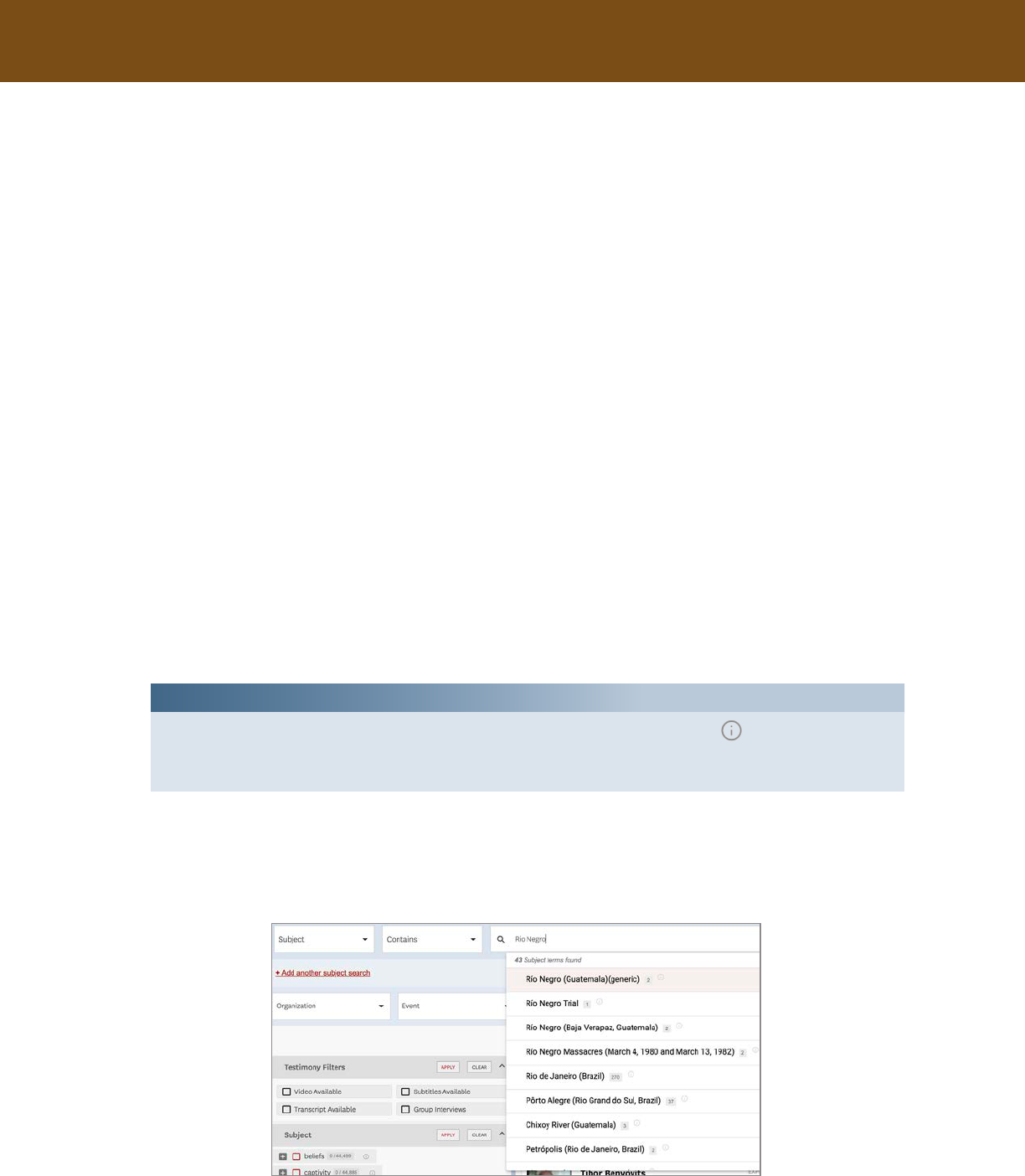
USC Shoah Foundation | 25
Visual History Archive (VHA) User Manual
Subject Search
Subject Search exclusively seeks testimony content that references specic indexing terms from
the keywords in the Visual History Archive. is specicity oers greater precision and, thereby, may
generate more focused and manageable search results.
is search allows users to combine multiple indexing terms, such as “Tutsi identity” and
“education,” to nd segments in testimonies in which these topics are discussed in relation to each
other.
Subject Search integrates all of the ltering options described in the Filtering section of this User
Manual. At any time, you may reduce your results using any of the lters onscreen. With the Add
another subject search function, Subject Search also oers And, Or and Not search combination tools
with the same principles as described in the Keyword Search section above.
AUTo-SUggeSTed SUbjecT TermS
Unlike Keyword Search, Subject Search does not accept free text submissions. Because the range
of possible submissions in Subject Search is limited by the VHA’s glossary of indexing terms, the
integration of auto-suggested terms in Subject Search is more sophisticated, oering several means to
customize the auto-suggest recommendations you receive before you submit a query.
e default auto-suggestion option in Subject Search is Contains. is is the broadest option,
recommended for VHA users who are not yet certain which terms exist that may yield the sorts of
testimony segments they are looking for.
Note:
When browsing auto-suggested terms in Subject Search, you may click the icon adjacent to
each term to read the VHA’s associated definition for that term, as well as any synonyms and
additional metadata about it. This can help you choose the term most appropriate for your inquiry.
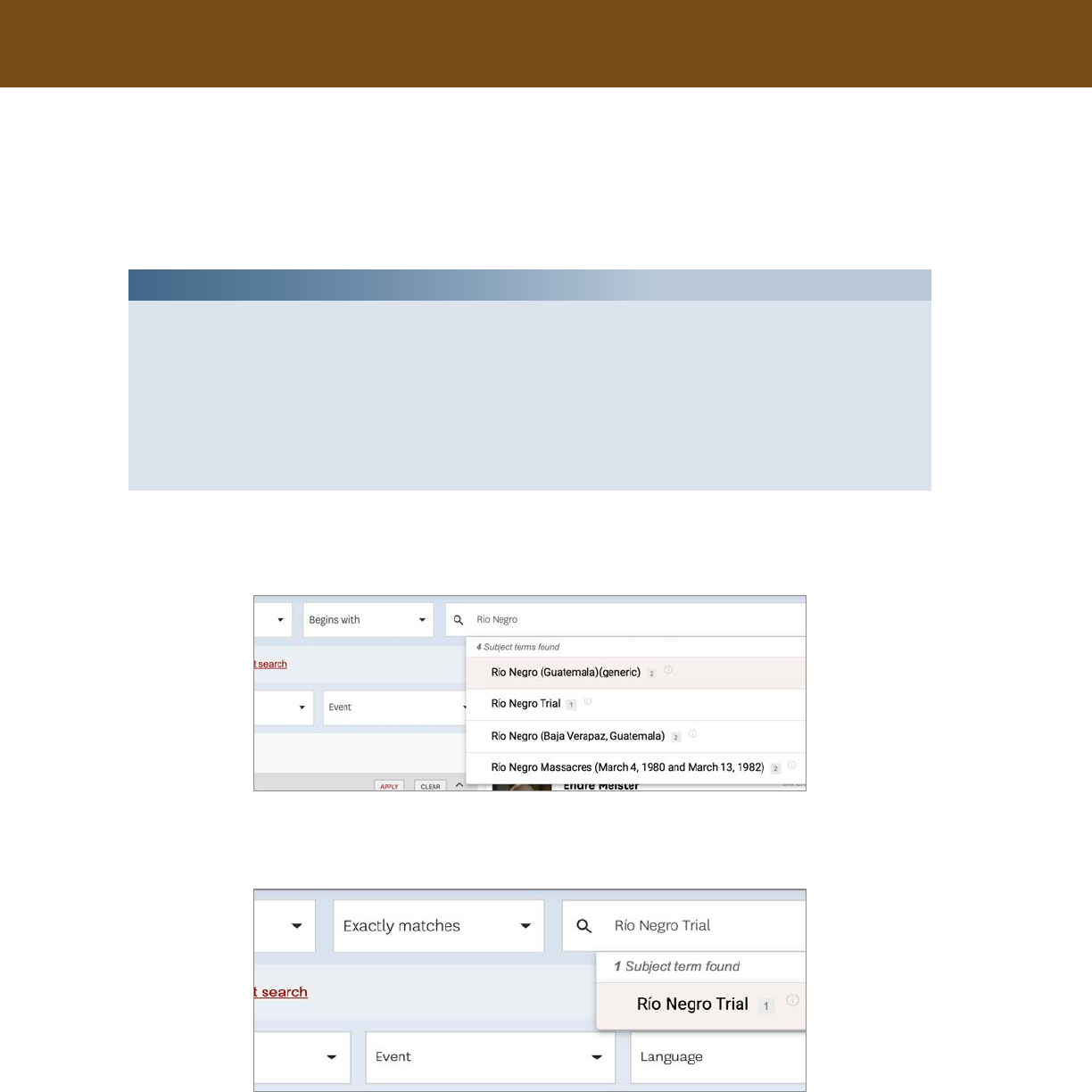
26 | USC Shoah Foundation
Visual History Archive (VHA) User Manual
When set to Contains, Subject Search will auto-suggest all terms that contain the text of your
search word. e word itself does not necessarily need to appear in the indexing term; it may be
contained in the associated synonyms for that term.
Choosing the Begins With option for auto-suggest will exclusively present subject terms for which
the name (or a synonym) starts with all or part of the submitted text.
e most focused and restrictive auto-suggest option is Exactly Matches, which will only show
results that feature precisely the same text as a keyword or one of its synonyms.
Use of Exactly Matches auto-suggestion is only advisable for users who know the precise title of
the term they wish to search for.
Note:
The VHA’s library of synonyms helps users find results in cases when multiple spellings may be
common (e.g., “Nanking” as a synonym of “Nanjing”), and also when specific accent marks or
special characters from the VHA’s numerous languages might render it difficult for a user typing on
a English-language keyboard to find the results they are looking for.
If, in your use of the VHA, you believe that a spelling synonym should be added to the index, please
write to [email protected], or click HELP at the top of your VHA browsing window.
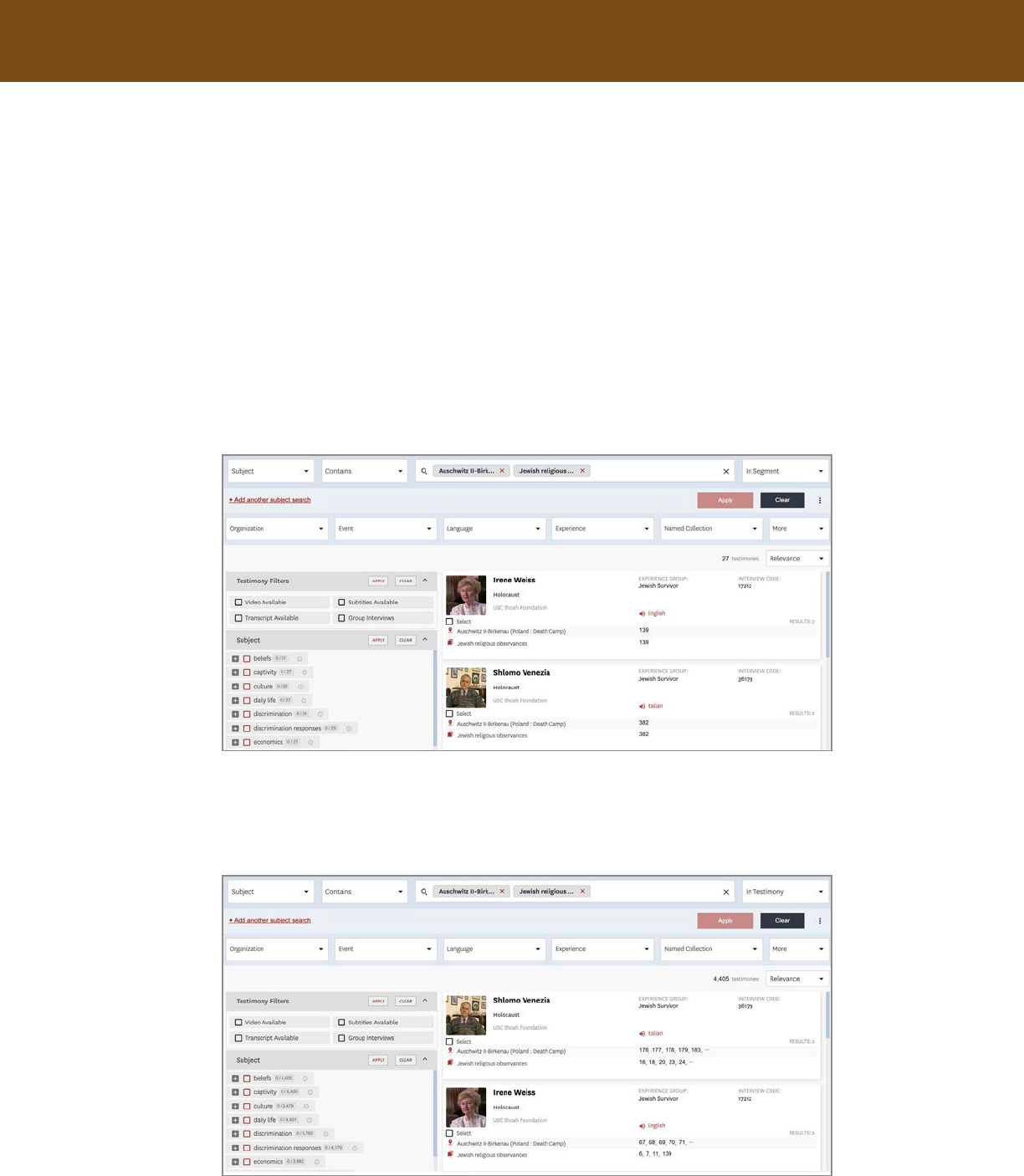
USC Shoah Foundation | 27
Visual History Archive (VHA) User Manual
“in SegmenT” And “in TeSTimony” SeArching
With Subject Search, users can query the archive for full testimonies, or individual segments of
testimony, in which multiple specic subject terms appear. is scope can be adjusted by clicking the
far-right dropdown beside the search box. Two options are oered: In Segment and In Testimony.
If seeking to nd segments of testimony in which interviewees speak about Jewish religious
practice within Auschwitz II-Birkenau death camp, an In Segment Subject Search would be ideal.
By submitting both the term “Auschwitz II-Birkenau (Poland : Death Camp)” and the term “Jewish
religious observances” (which may be discovered by typing “Auschwitz” or “Jewish holiday” into a
Contains search) inside of the same In Segment query, all testimony segments in which both of these
topics are discussed will appear in your results. In Segment is the default option for Subject Search.
In contrast, applying these same terms to an In Testimony Subject Search will display all
testimonies in which they appear across the span of the interview’s indexing (e.g., testimonies in
which an interviewee speaks at some point about both the Auschwitz II-Birkenau death camp and
about Jewish religious observances, but not necessarily in the same segment).
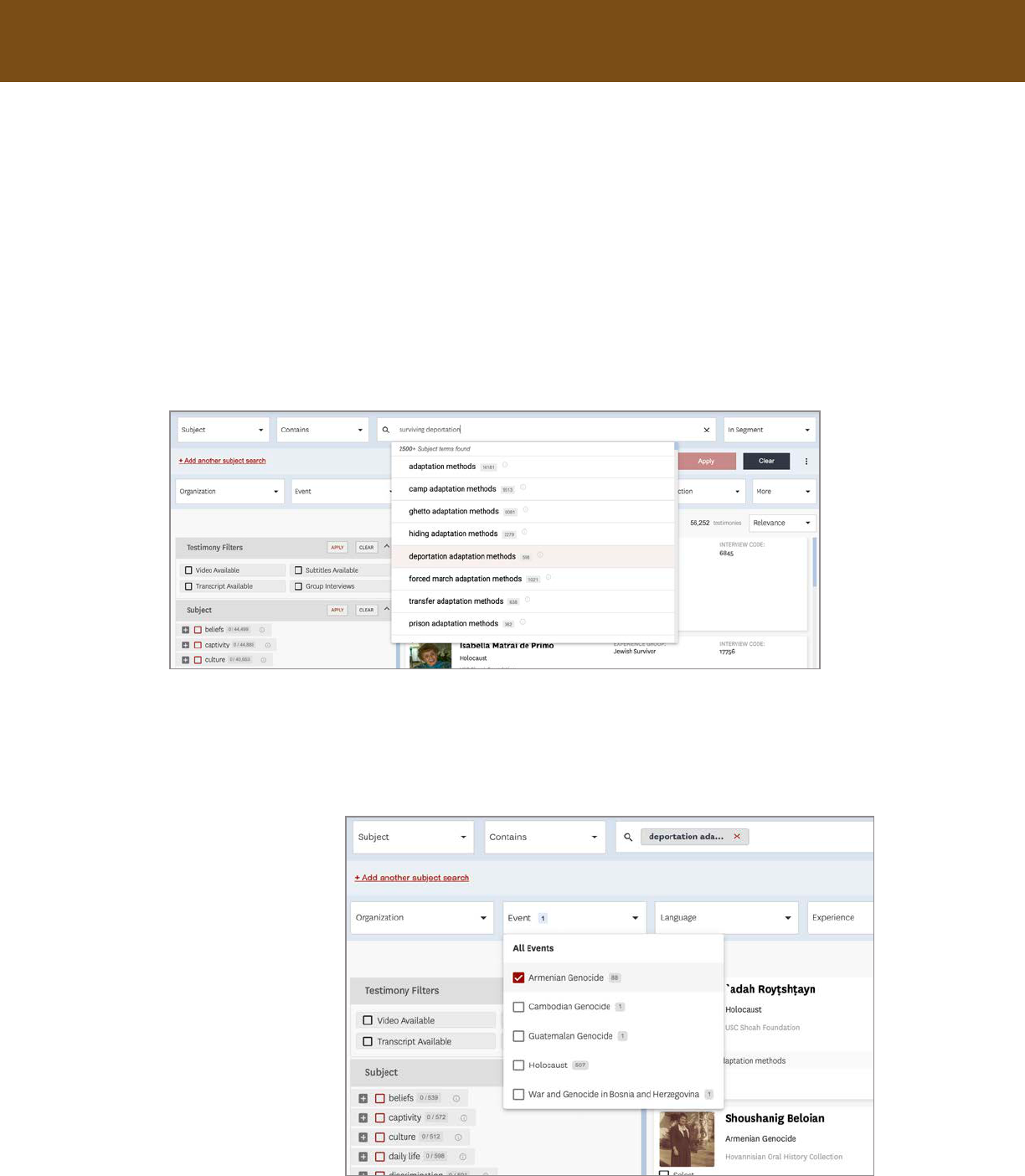
28 | USC Shoah Foundation
Visual History Archive (VHA) User Manual
SUbjecT SeArch exAmple: how did people SUrvive deporTATionS dUring
The ArmeniAn genocide?
A Visual History Archive user seeking to conduct research into how individuals survived
deportations during the Armenian Genocide could nd relevant testimony using Subject Search.
Typing “surviving deportation” in the search bar set to Contains auto-suggest will present a series
of subject terms—one of which is “deportation adaptation methods.” is, among the suggested
terms, appears to be the most likely to be relevant for this research question.
For a query featuring a single Subject term, it does not matter whether the search is submitted as
In Segment or In Testimony. But if one wished to reduce results to another specic related term being
discussed in conjunction with deportation adaptation methods, they might add another term here and
submit as In Segment.
Upon applying the
“deportation adaptation
methods” Subject Search,
a user will see over ve
hundred testimonies, many
of which are related to the
Holocaust. Because this
particular research question
is focused on the Armenian
Genocide, the number of
results could be reduced
considerably by clicking
the Event dropdown
lter, choosing Armenian
Genocide, and then
clicking Apply.
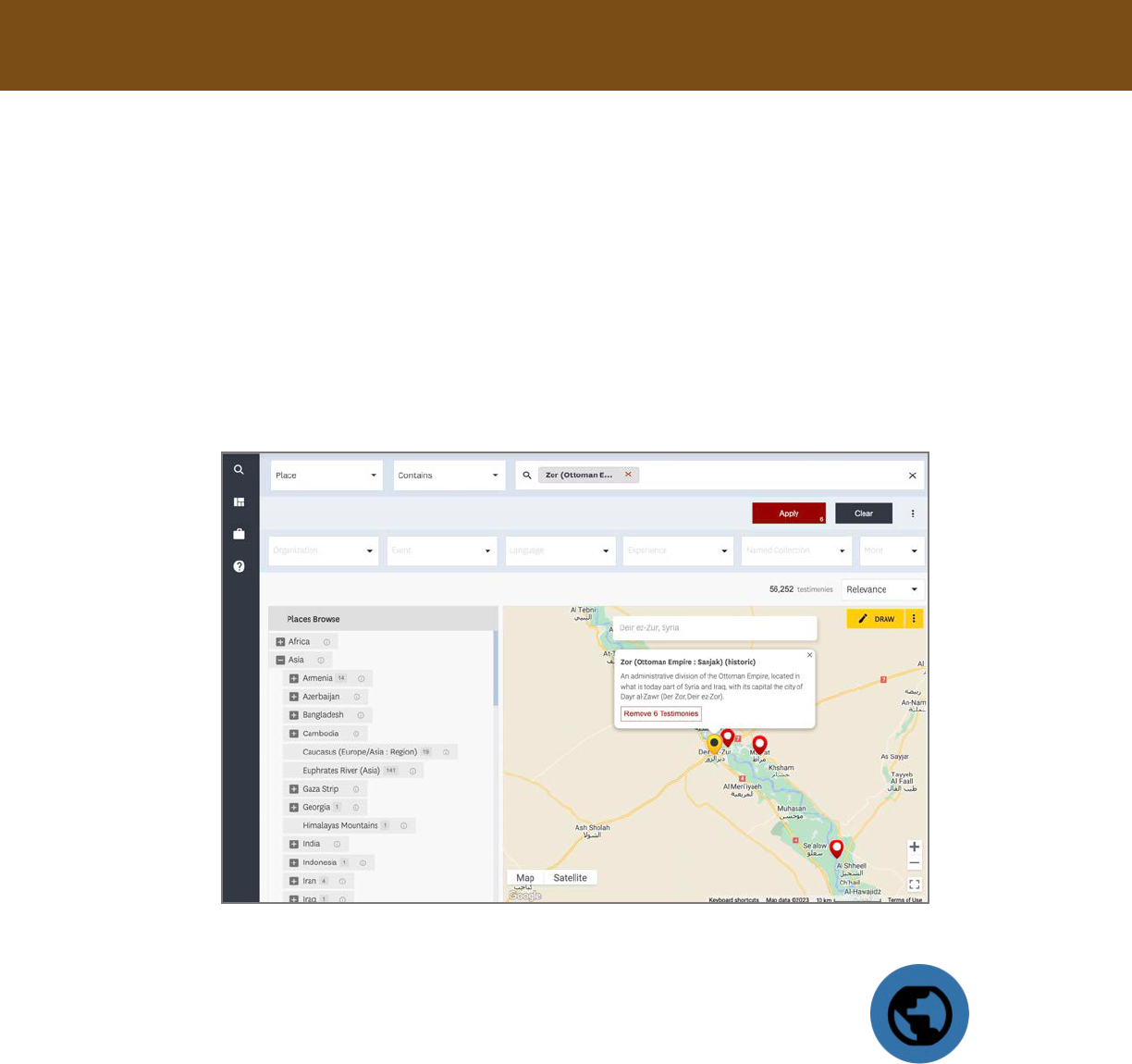
USC Shoah Foundation | 29
Visual History Archive (VHA) User Manual
Place Search
Users performing testimony-based research related to one or more specic geographies will
benet from Place Search. Place search derives its results using Place indexing terms: these include
countries, towns, districts, geographic features (such as oceans, forests and rivers) and other sites such
as concentration camps and ghettos..
Place search integrates Google Maps to plot all locations referenced in Visual History Archive
testimony onto an interactive map, which can operate in and of itself as a fully edged search tool.
Clicking any pin in the map will allow you to view all testimonies that reference the associated place.
Place Search oers three methods of submitting a search query:
Upon submitting a Place Search query, ltering and browsing results works as
described in Filtering (page 5) and Understanding Search Results (page 12) in this
User Manual. e blue globe icon depicted to the right will return to the map.
SeArch bAr
e Search bar uses the same auto-suggest functionalities as Subject Search (see page 25), except
that it exclusively searches using Place indexing terms. As with Subject Search, the search bar in
Place Search does not allow free text submissions. Contains, Begins With and Exactly Matches auto-
suggestion functionalities function as described above for Subject Search.
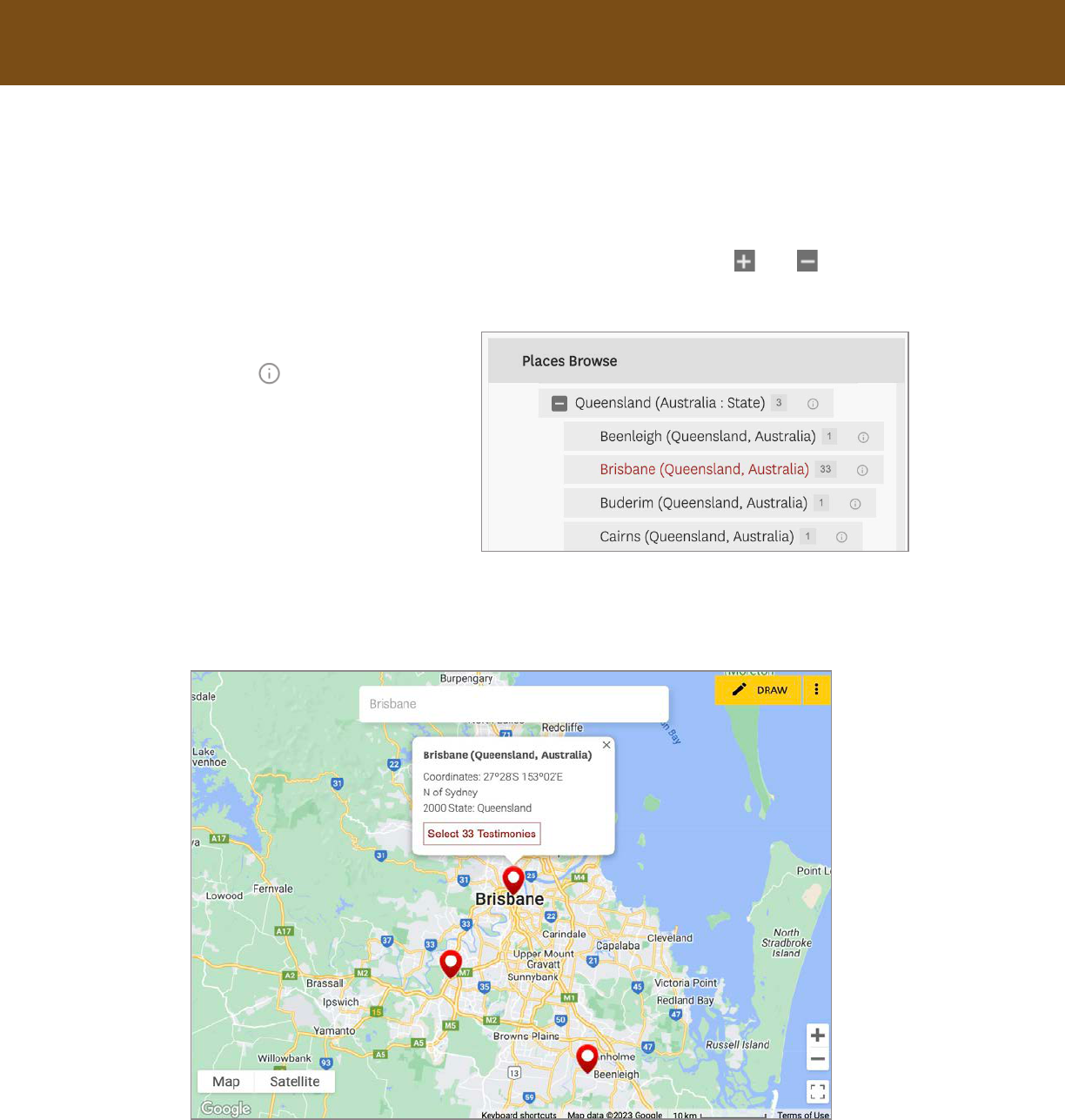
30 | USC Shoah Foundation
Visual History Archive (VHA) User Manual
plAceS browSe
e Places Browse left sidebar oers an organized list of all Place indexing terms in the VHA,
sorted into hierarchical topic trees. Trees are expanded and condensed with the and icons,
respectively. e top parents of these trees are mostly continents and large bodies of water; most of
their children terms are countries, usually followed by states, districts, towns and then possible specic
sites such as concentration camps.
Clicking the icon beside any
of these will display an indexing term
denition. A number on the right indicates
that this specic term is indexed in that
number of testimonies; so from the image
to the right, we know that Brisbane
(Queensland, Australia) will show 33
relevant testimonies.
To submit a query from Places Browse, simply click the text of the term itself. e Google Map
will then reorient to center the chosen term. en, click Select xy Testimonies, and then Apply to
submit a search.
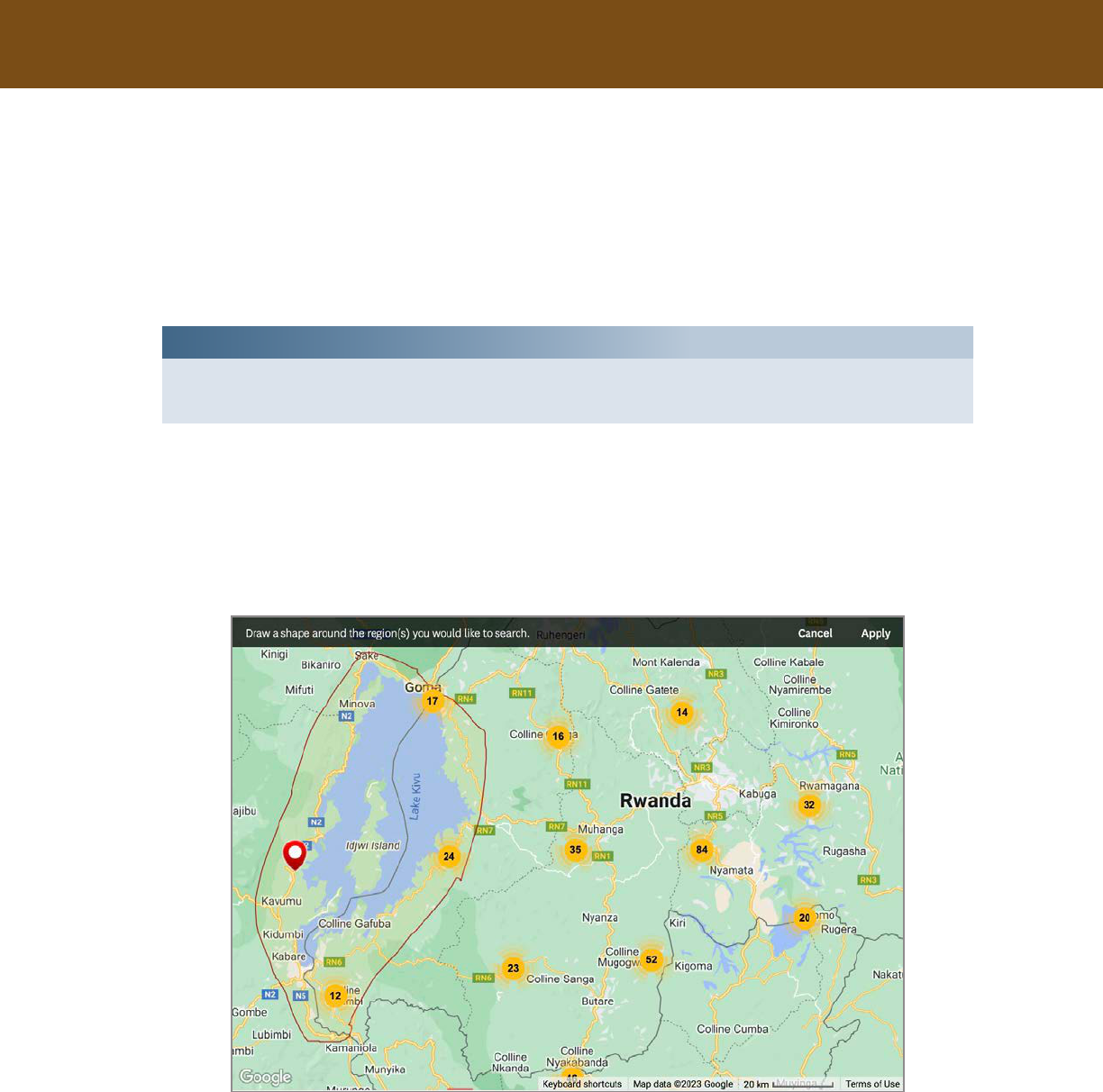
USC Shoah Foundation | 31
Visual History Archive (VHA) User Manual
drAw
e nal search query format available in Places Search is Draw—in which users may draw a
shape directly onto the Google Map, and receive results corresponding to all Place indexing terms
within that shape.
To initiate a Draw search, click the yellow Draw button located at the top-right of the Google
Map window. en, draw a complete shape on the map for the region you want your search to cover.
If you release the mouse at any time, the shape will enclose itself with the most direct possible straight
line between the point where the mouse was released and the point where the line began.
Your completed shape will display with a yellow tint and a red outline on the map.
If content with the shape, click Apply.
Note:
Before beginning a Draw search, you may wish to use the white search bar inside the Google Map
to quickly center your map around the region you want your query to focus on.
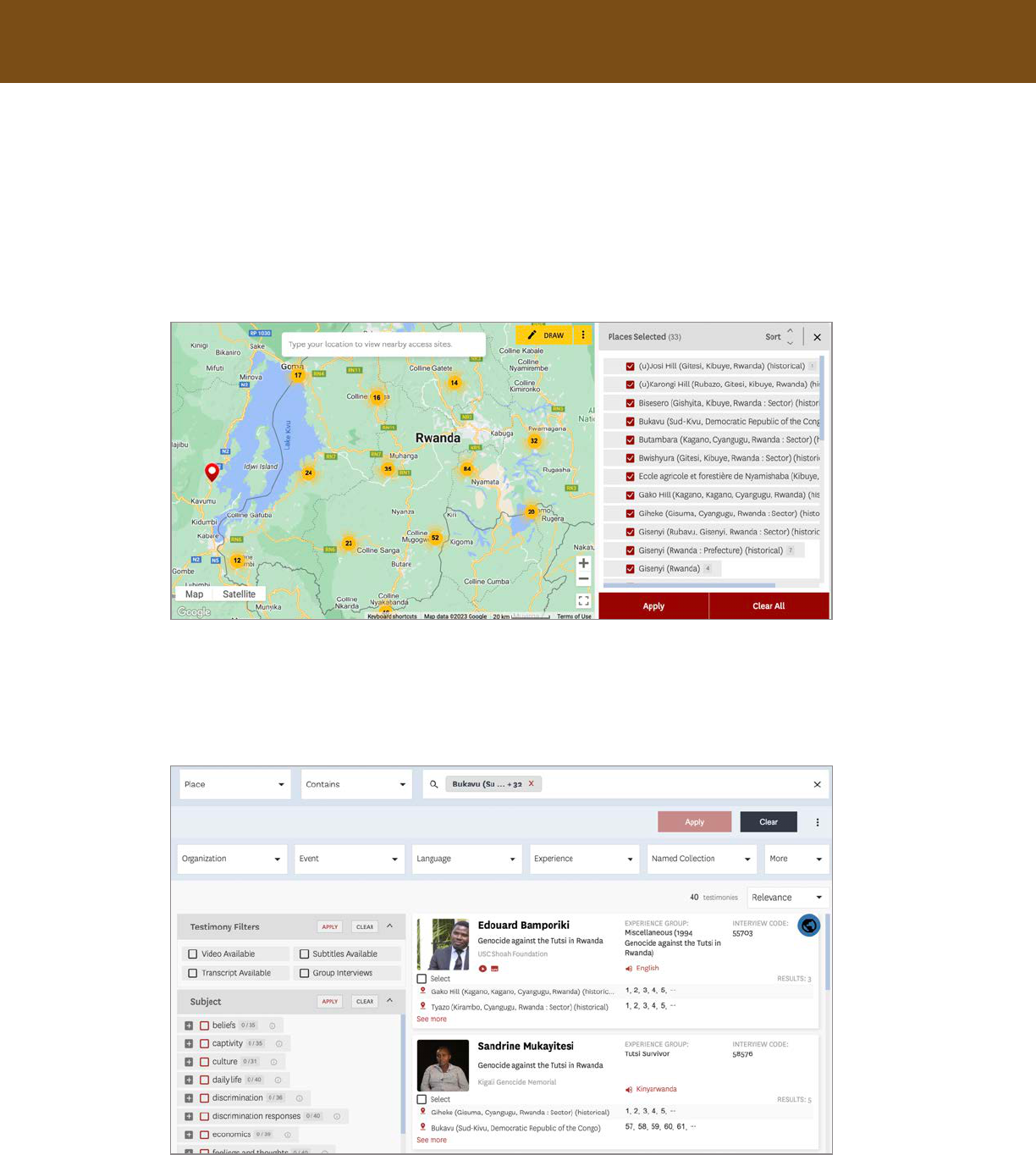
32 | USC Shoah Foundation
Visual History Archive (VHA) User Manual
is will display Places Selected—a list of all Place indexing terms that appear geographically
within the shape you submitted. Each of these can be individually removed from the search by
un-checking them from the list. Indicator numbers beside each term show how many testimonies
reference it. At any time you may click a term to center the map on that particular location, and read
its indexing term denition.
When satised with your selections, click Apply, located both above and below the Places
Selected list. is will open a Search Results page with an OR search for all the places included on
your list, displaying all testimonies which reference any of them. Each testimony card indicates which
locations are referenced, and which segments they appear in.
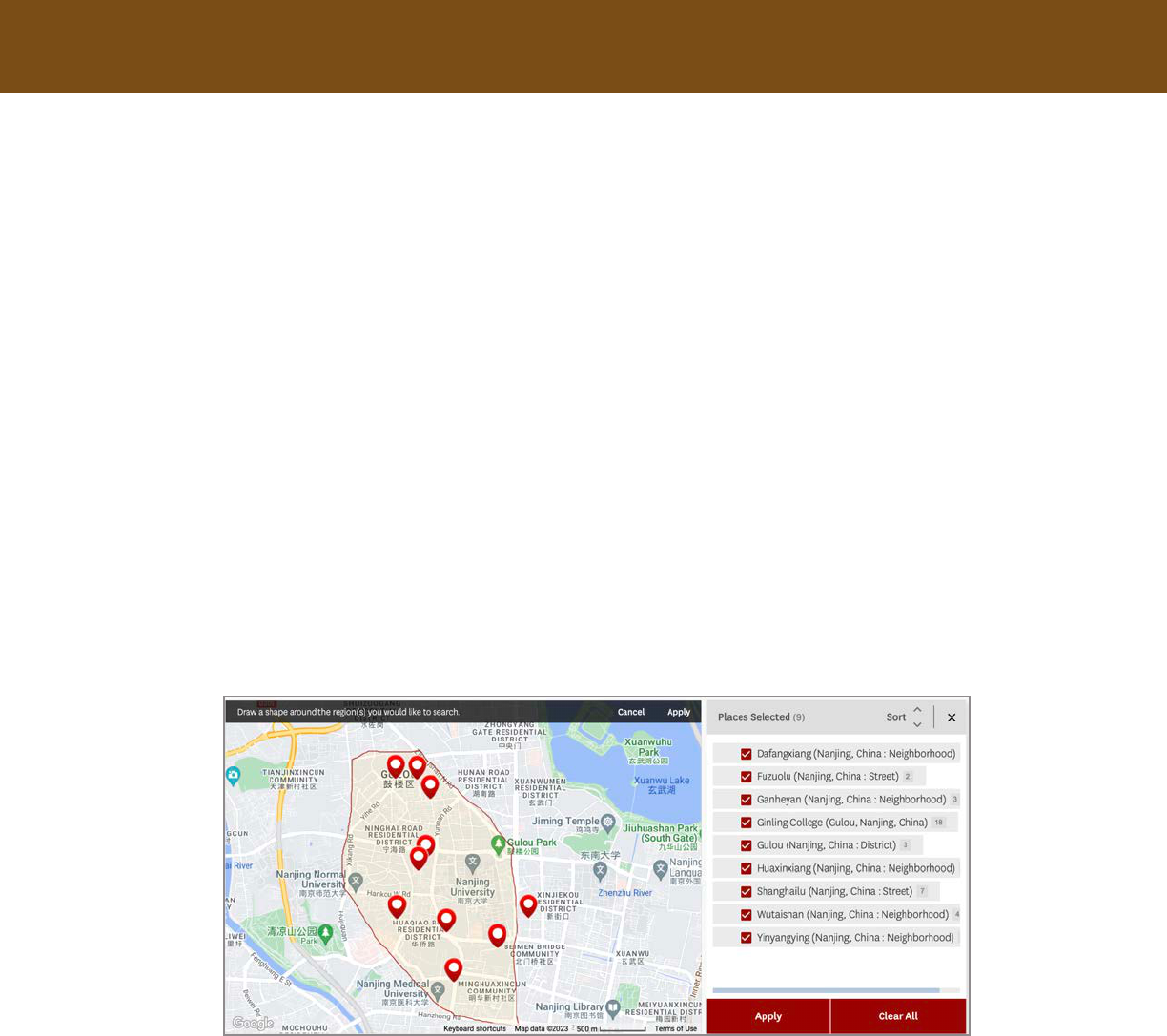
USC Shoah Foundation | 33
Visual History Archive (VHA) User Manual
plAce SeArch exAmple: how did nAnjing mASSAcre SUrvivorS SpeAK
AboUT The neighborhoodS ThAT compriSed The nAnjing inTernATionAl
SAFeTy Zone?
A user seeking to discover all segments of testimony that discuss the neighborhoods that
comprised the protected Nanjing International Safety Zone from December 1937 to February 1938
would be wise to utilize the Draw function in Place Search.
“Nanjing International Safety Zone” is a Place term in and of itself—but a search for this term
alone may miss references to the particular streets and neighborhoods within its bounds, before and
after the Safety Zone existed. To this end, a Draw search that outlines the shape of the Safety Zone
will yield all testimony that references all Place indexing terms within.
is user could begin by typing “Nanjing” into the white search bar inside the Google Map will
center the map on Nanjing, speeding up the process. ey could then click Draw, and form the shape
of the Nanjing International Safety Zone on top of the map with their mouse.
Clicking Apply in the Google Map would show nine place terms indexed for the shape.
e red Apply button below the Places Selected list would then submit the search for all nine
terms, yielding segments from 34 dierent testimonies that reference them.
All ltering tools will then be available to curate the search results however desired by the user.
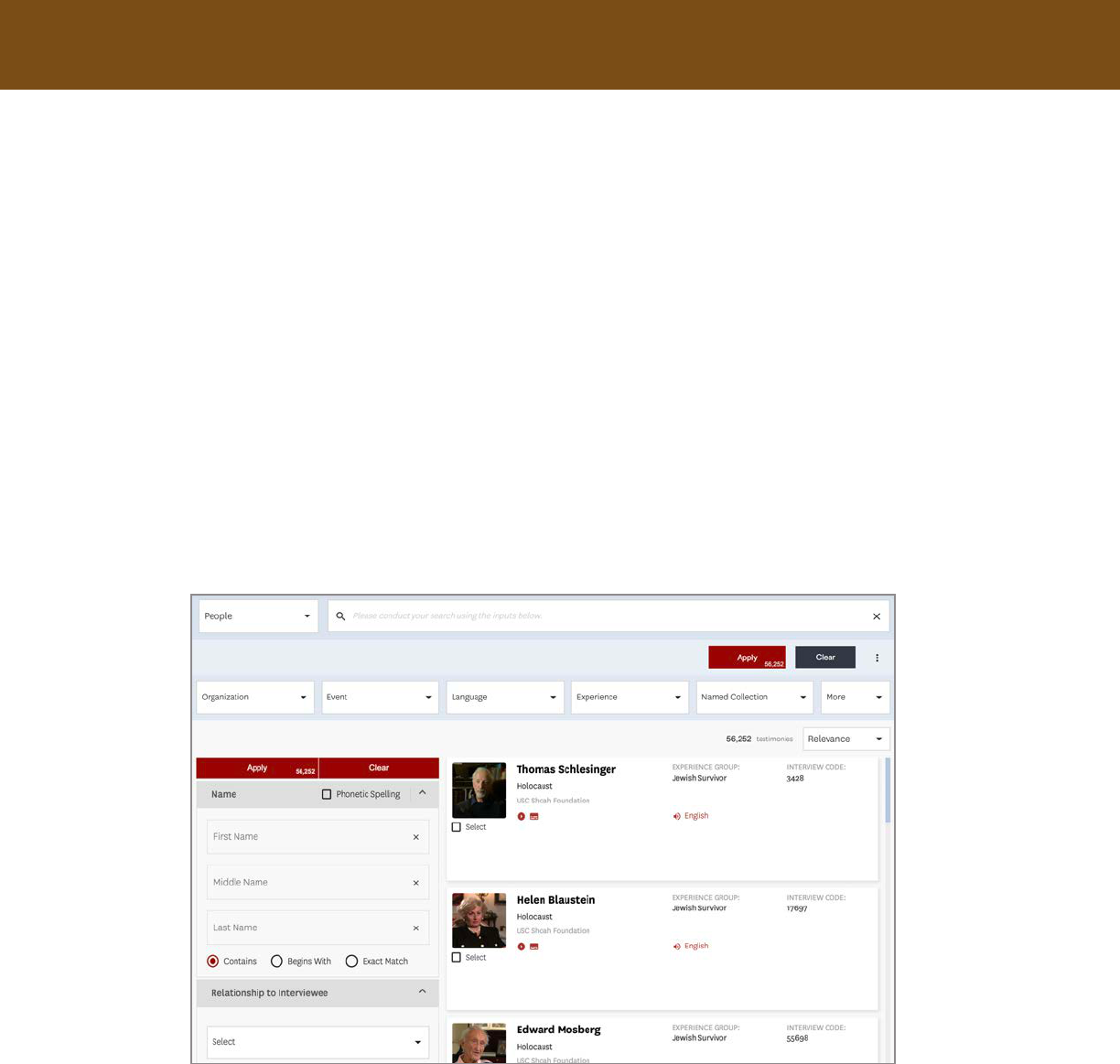
34 | USC Shoah Foundation
Visual History Archive (VHA) User Manual
People Search
An advanced search option for those seeking to research specic individuals or categories of
individuals—whether they were interviewees themselves, people referenced in testimonies or workers
who supported the USC Shoah Foundation testimony collection process—People Search supports
numerous use cases with a series of powerful tools and lters, introduced here.
Within the 56,000 testimonies in the VHA, approximately two million people are referenced by
name—and each of these references is searchable, down to the testimony segment, through People
Search.
Upon choosing People from the search type dropdown or from keyword search suggestions, the
primary search bar will no longer operate, instead displaying the message “Please conduct your search
using the inputs below.” However, the dropdown lters (page 5 of this User Manual), and the Apply,
Clear, Save search results and Save search parameters functions all operate in People Search as they do
with the other three search types.
Instead, most input options for a People Search query are available through a variety of unique
tools incorporated into the People Search left sidebar, which completely replaces the left sidebar lters
that appear in other searches (page 6 of this User Manual) until a query is submitted.
A closer look at the People Search left sidebar is included on the following page.

USC Shoah Foundation | 35
Visual History Archive (VHA) User Manual
people SeArch inpUTS
None of the inputs in the People Search left sidebar
is required. Click Apply at any time to generate results,
or Clear to start anew.
Once three or more letters have been inputted into
the First Name, Middle Name or Last Name elds,
suggested names will be listed. ese suggestions
incorporate the same Contains/Begins With/Exact Match
options available in Subject and Place Search.
e Phonetic Spelling option is often helpful.
Because of the diversity of languages and places of origin
reected in the stories chronicled in the Visual History
Archive, diacritic marks and variable spellings can
complicate name searching. Phonetic Spelling is USC
Shoah Foundation’s eort to mitigate this, implementing
the Beider-Morse Phonetic Matching (BMPM)
system developed by Alexander Beider and Stephen P.
Morse to present suggested names that share a similar
sound, even if they are spelled radically dierently.
e Relationship to Interviewee dropdown lists all
categories of relationship that appear in People term
indexing in the Visual History Archive. is menu
features checkboxes, so multiple options can be picked.
Note that Interviewee is listed rst. Interviewer and
Videographer can also be chosen to view all testimonies
respectively conducted or lmed by a certain individual.
Birth and Death information was recorded
wherever possible for interviewees and non-interviewees
alike. You may lter by birth and death time spans with
months and years as boundaries. e location options all
include Contains/Begins With/Exact Matches suggestion
tools. Note that Birthplace and Deathplace are distinct
categories, referring to non-city places (e.g., someone
who died at Auschwitz II-Birkenau or someone born
in a kibbutz). e Type of Death dropdown is another
checkbox menu, in which multiple items can be picked.
Finally, the Survivor option lters for individuals
who survived (Yes), or did not survive (No), the focal
Event discussed in the particular testimony.
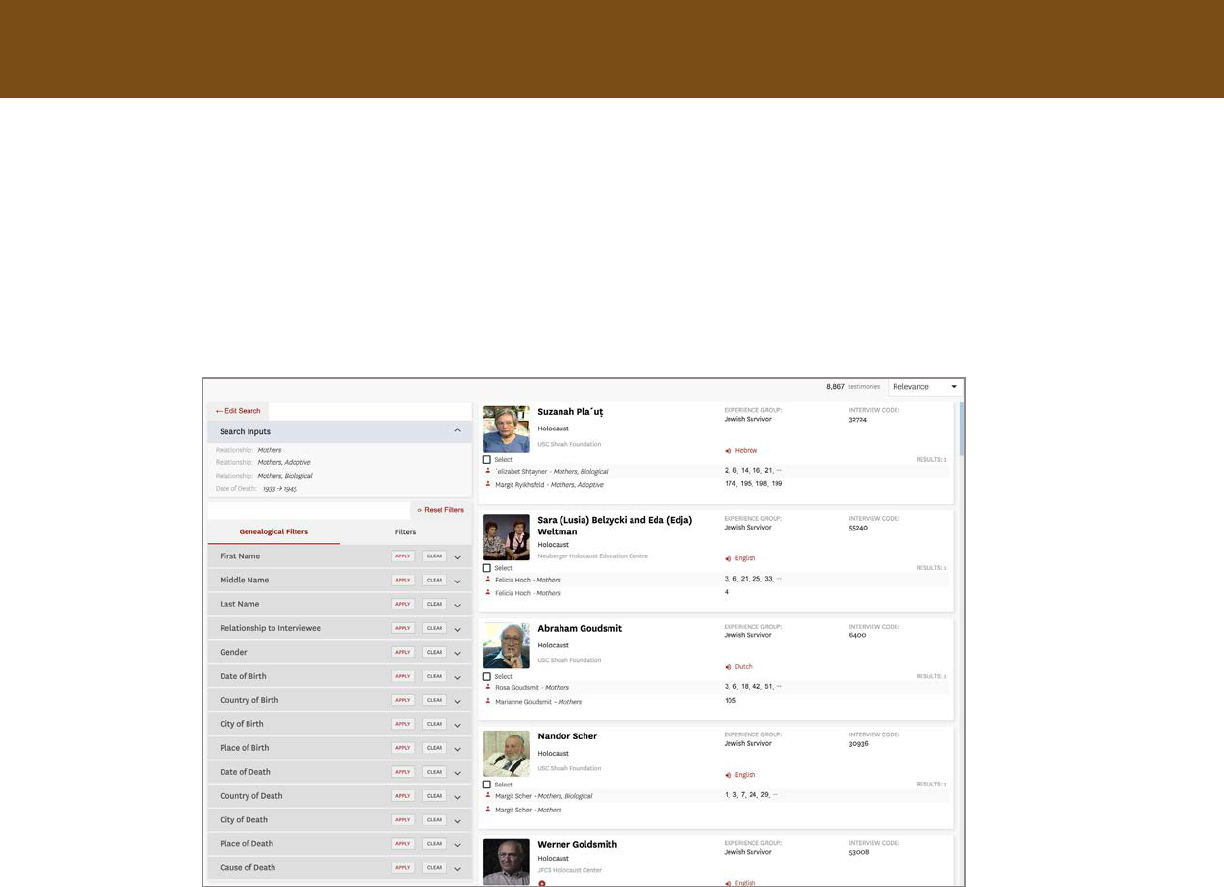
36 | USC Shoah Foundation
Visual History Archive (VHA) User Manual
FilTering A people SeArch
Once a set of People Search inputs is applied, both the search results and the left sidebar of the
search page will change. Search results will refresh based on your inputs; the left sidebar will shift to a
series of filtering options.
e submitted search inputs will be itemized in the Search Inputs box in the top-left. Clicking
Edit Search at any time will return to the People Search left sidebar described on the previous page,
with all submitted query parameters retained.
Below, two ltering tabs are displayed in the left sidebar: Genealogical Filters and Filters.Each of
these oers a myriad of additional ltering options, each bearing their own Apply and Clear options.
Reset Filters will clear everything inputted here without clearing the original People Search
inputs.
Clicking Filters oers access to the standardized left sidebar lters (described on page 6 of this
User Manual) that appear in the other three Visual History Archive search types.
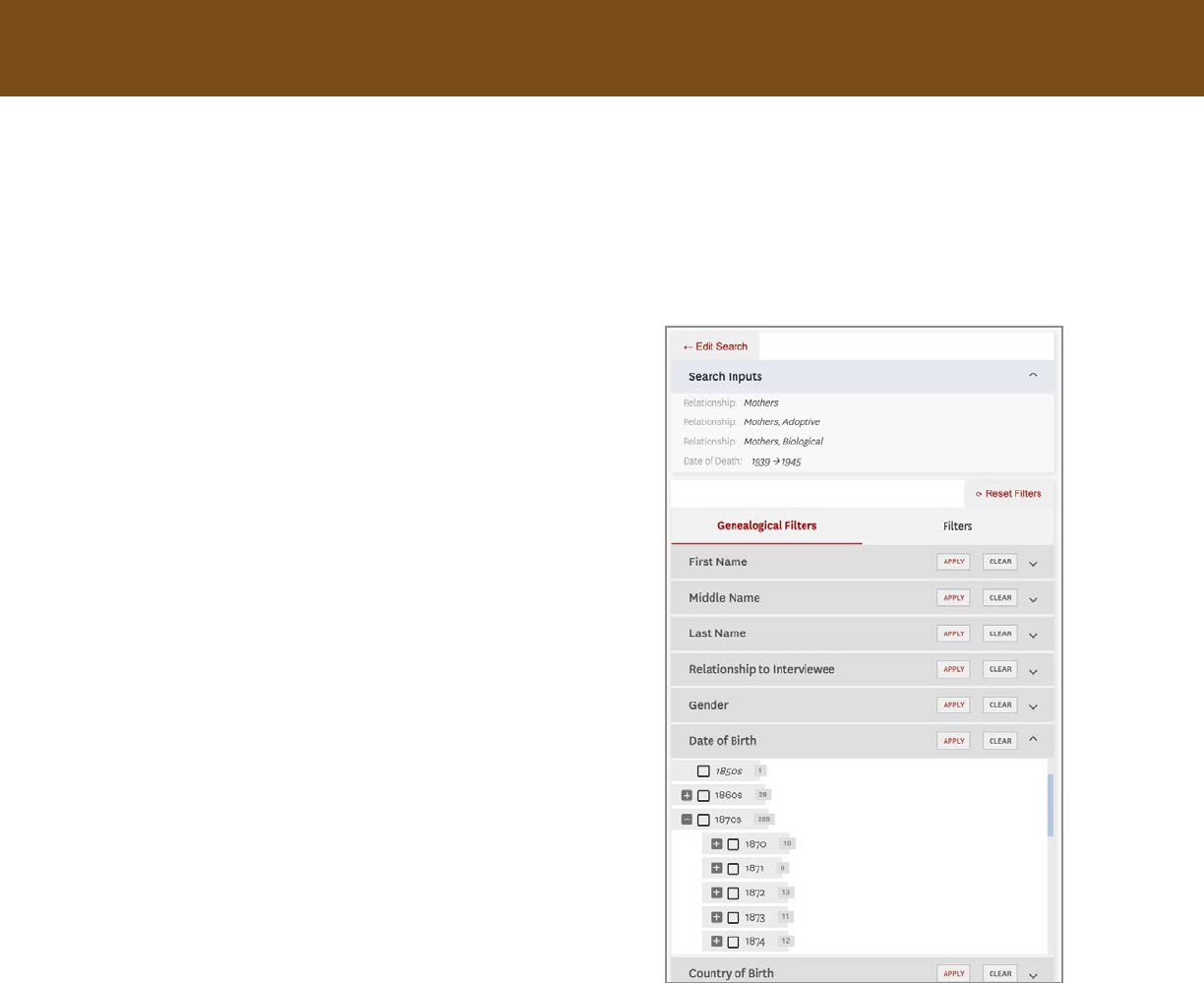
USC Shoah Foundation | 37
Visual History Archive (VHA) User Manual
e Genealogical Filters option is also unique to People Search. is presents all the same input
categories that are available in the People Search left sidebar, reorganized into a series of checkbox
menus reective of the recorded genealogical data in the Visual History Archive pertaining to all
people within the list the original search inputs generated.
In the example on the right, the original search
inputs tracked adoptive and biological mothers
referenced in the VHA who died between the years
1939 and 1945. Search results would currently feature
all segments in which these mothers are discussed.
Opening the Date of Birth list under Genealogical
Filters, then, lists the recorded years and months of
birth of these various adoptive and biological mothers,
based on the data USC Shoah Foundation has on
record.
Each of these can be checked for inclusion, and
each parent topic is inclusive of all its children. For
example, on the right: checking the box beside 1870,
and then clicking Apply beside Date of Birth, would
submit all months of 1870 as potential months of
birth, and it would yield 10 results based on the ten
mothers referenced in VHA testimony who died
between 1939 and 1945 (per Search Inputs) and were
born in the year 1870 (per Genealogical Filters).
e various categories can be added, altered and
removed at the user’s discretion, using the various
Apply, Clear, Reset Filters and Edit Search buttons.
people SeArch exAmple: whAT SimilAriTieS cAn be FoUnd beTween
renée FireSTone’S own TeSTimony And ThoSe in which She Served AS
inTerviewer?
People Search results include both the interviewees and interviewers featured in Visual History
Archive testimonies. In some cases, interviewees who gave testimony to USC Shoah Foundation also
helped conduct interviews for other testimonies that appear in the VHA. Jewish Holocaust survivor
Renée Firestone was one such interviewee, and interviewer.
A user seeking to compare Renée’s testimony as interviewee with her practices as a testimony
interviewer might begin with the testimony Renée gave USC Shoah Foundation in 1994.
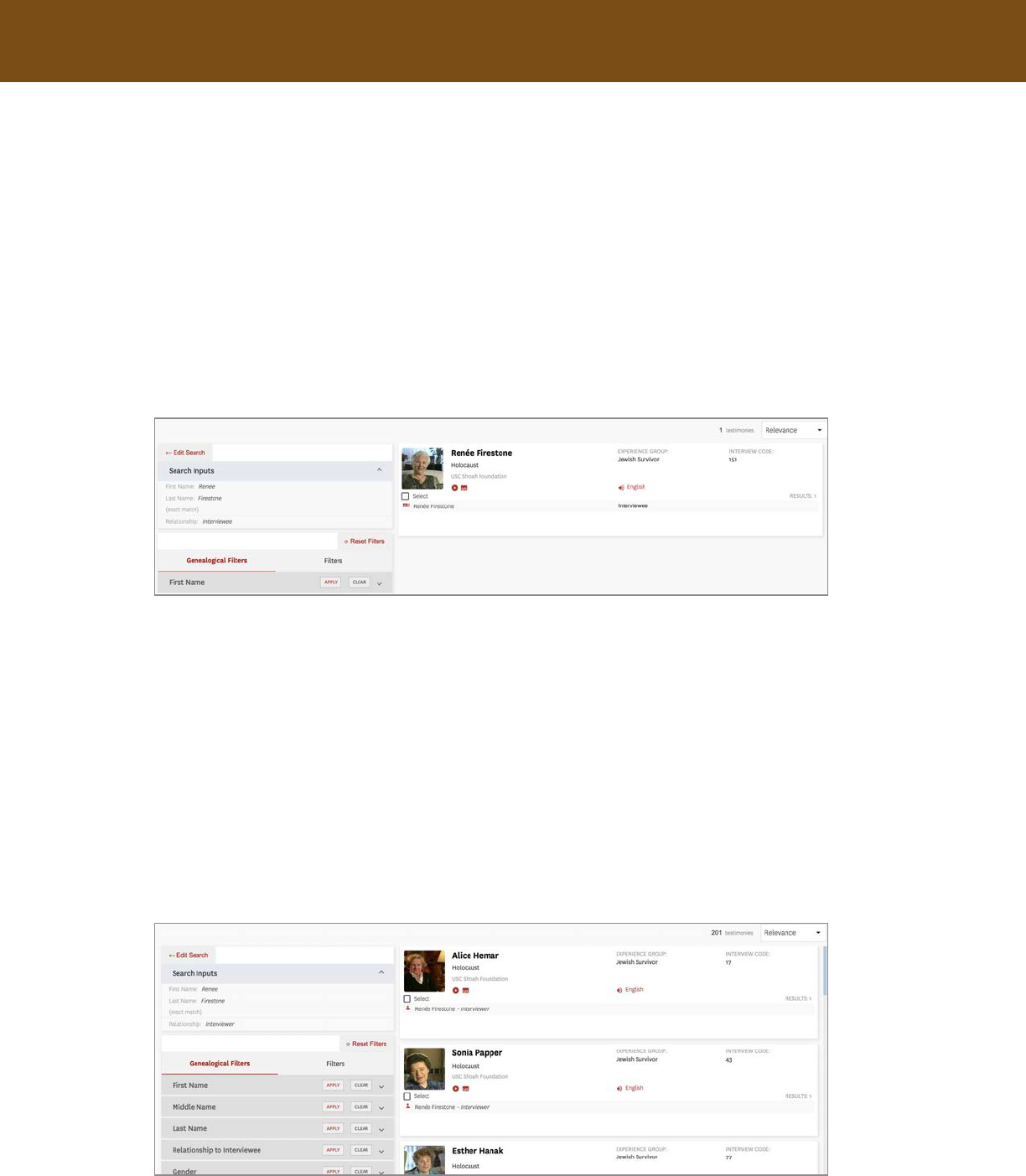
38 | USC Shoah Foundation
Visual History Archive (VHA) User Manual
To nd the testimony Renée gave using People Search, one could type “renee” (frequently, diacritic
marks such as the "é" in "Renée" are not required to generate accurate results) into First Name and
"restone" into Last Name in the People Search left sidebar.
Submitting this name data alone would not be specic enough, however, as the results would
also show any segments of testimony in which Renée was referenced by another interviewee, as well
as any testimonies in which she conducted the interview. To this end, to nd the testimony in which
she was interviewed, the user would need to select Interviewee under the Relationship to Interviewee
dropdown menu before clicking Apply at the top of the sidebar. As shown below, this generates a
single result—the interview with Renée we are looking for.
Having found the testimony in which Renée was interviewed, the user could then rework their
search inputs to nd the testimonies in which she was interviewer. To do this, they would begin by
clicking Edit Search in the top left to return to the People Search left sidebar.
e only input that would need to be changed is the Relationship to Interviewee dropdown.
e user would want to un-check Interviewee, and then scroll through the alphabetized list until
they nd Interviewer. After checking Interviewer, and clicking Apply, the user will see a list of 201
testimonies in which Renée Firestone served as interviewer. Filters could be applied in order to reduce
or focus thist further, using the dropdown lters above the results, or the Filters tab in the left sidebar.
In this particular case, no selections under the Genealogical Filters tab would have any bearing on
the search results, because the only genealogical data being utilized here pertains to one person: Renée
Firestone.
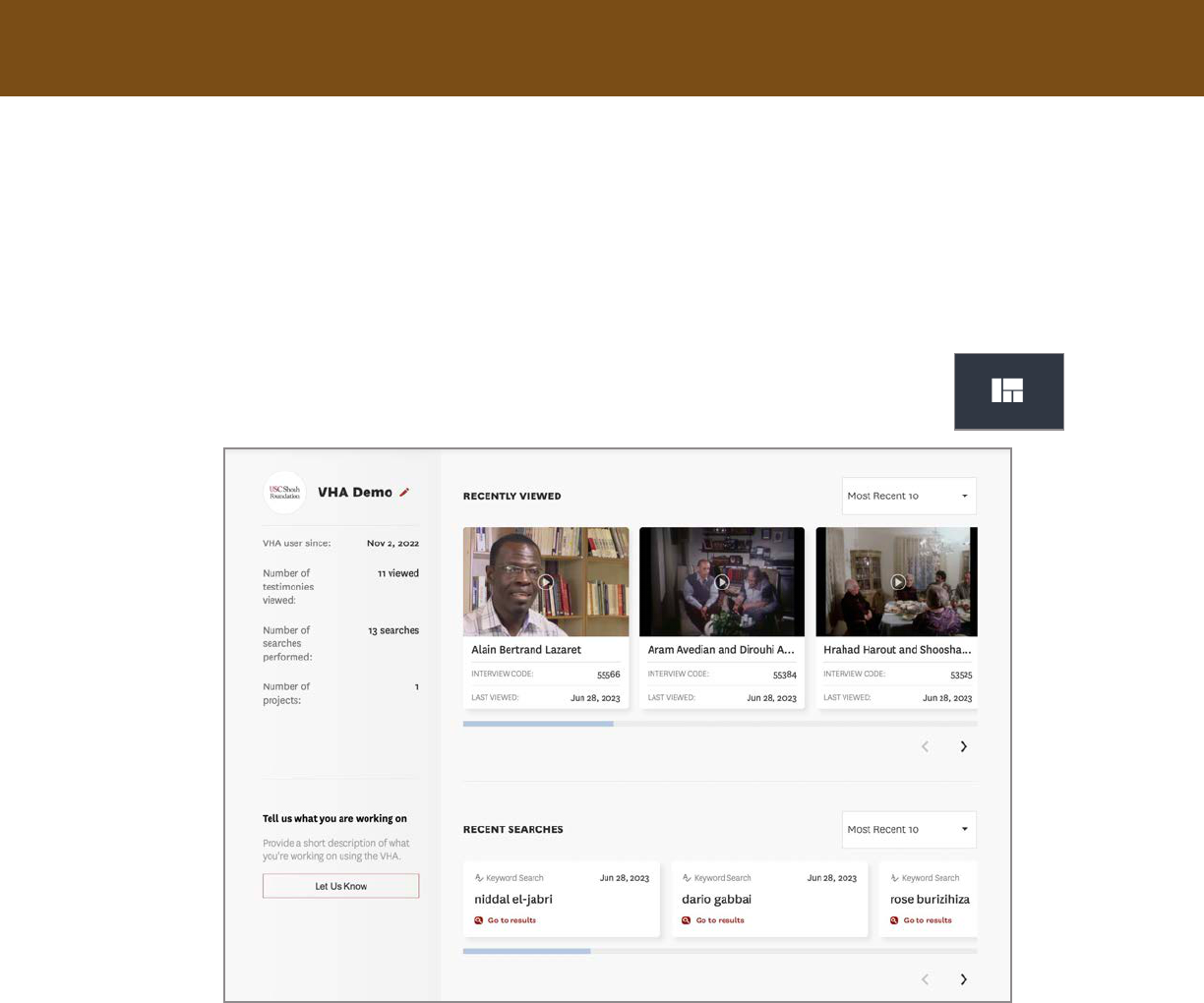
USC Shoah Foundation | 39
Visual History Archive (VHA) User Manual
Dashboard
e Visual History Archive Dashboard is each registered VHA user’s personalized home base for
ongoing research with the archive. It oers pathways to return to recent testimonies viewed, searches
submitted and projects accessed, as well as additional resources designed to support you.
e Dashboard opens upon VHA login, and it can be returned to at any time
using the grid icon in the left sidebar icon.
e Dashboard oers several key features
In the top-left, you may edit your profile information with the red pencil icon (including
password reset), and you can view statistics on your lifetime VHA use.
Below that, in the lower-left, the Tell us what you are working on tool allows you to submit a
message to USC Shoah Foundation regarding your VHA research; Institute sta may follow up, if
you indicate you wish to connect further.
On the right side of the page, you may review: your Recently Viewed testimonies, your Recent
Searches and your Recent Projects. Clicking any of the cards in these lists will open the corresponding
testimony, ltered search query or project, respectively, in your browser.
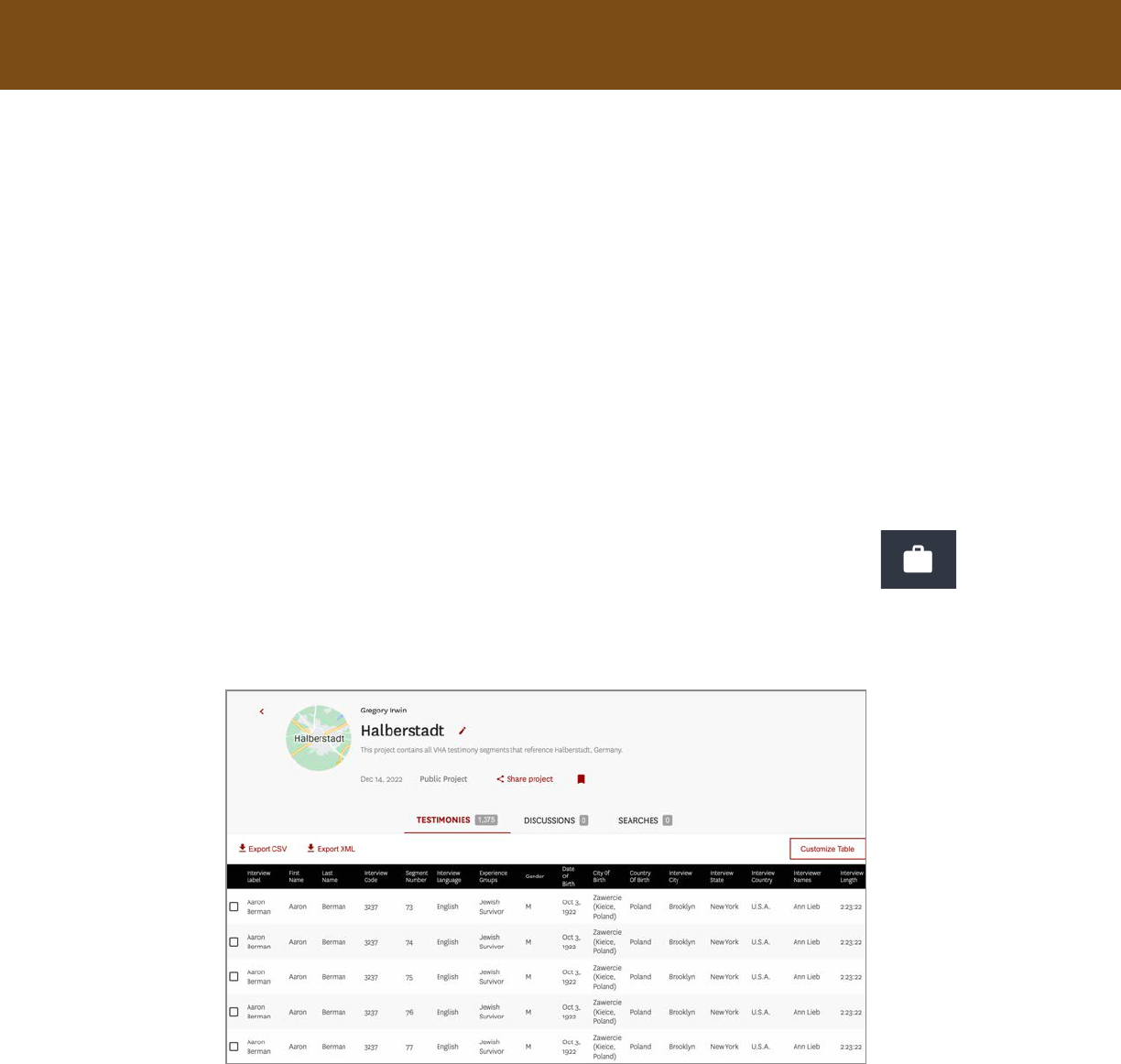
40 | USC Shoah Foundation
Visual History Archive (VHA) User Manual
Using the dropdown menus to the top-right of each, all three of these lists on the Dashboard
can show: Most Recent 10 testimonies/searches/projects accessed, or all that were accessed in the Past
Week, Past Month or Past Year. ese can allow you to quickly pick back up work from where you left
o. Or, if you want to return to some VHA testimony you had viewed in the past but did not save to a
project, the Dashboard would be a great place to retrace the work of your research.
Finally, at the bottom of the Dashboard, several Video Tutorials are available that quickly
introduce the VHA and its functions.
Projects
Visual History Archive Projects are customizable, shareable workspaces for keeping track of your
VHA research. Projects are only accessible for registered, logged-in VHA users.
To access your Projects, click the suitcase icon in the left sidebar.
To create a Project, click the Create Project button in the top-right of the Projects page, or save a
search result, segment or parameter into a New Project (see Saving Searches and Search Results on
page 10 of this User Manual).
Upon creating a Project with the Create Project button, you can customize your Project with a
name, a description and a thumbnail image. You may also indicate at this time whether your Project
will be private (for your access only when logged into your VHA account) or public (accessible to all
VHA users with a link to the Project). Public Projects can be password-protected here, also—allowing
you to share your work with trusted individuals and colleagues, rather than all VHA users.
ese settings can be changed at any time by clicking the red pencil icon that displays beside your
Project name while viewing it, such as seen beside the word Halberstadt in the screen above.
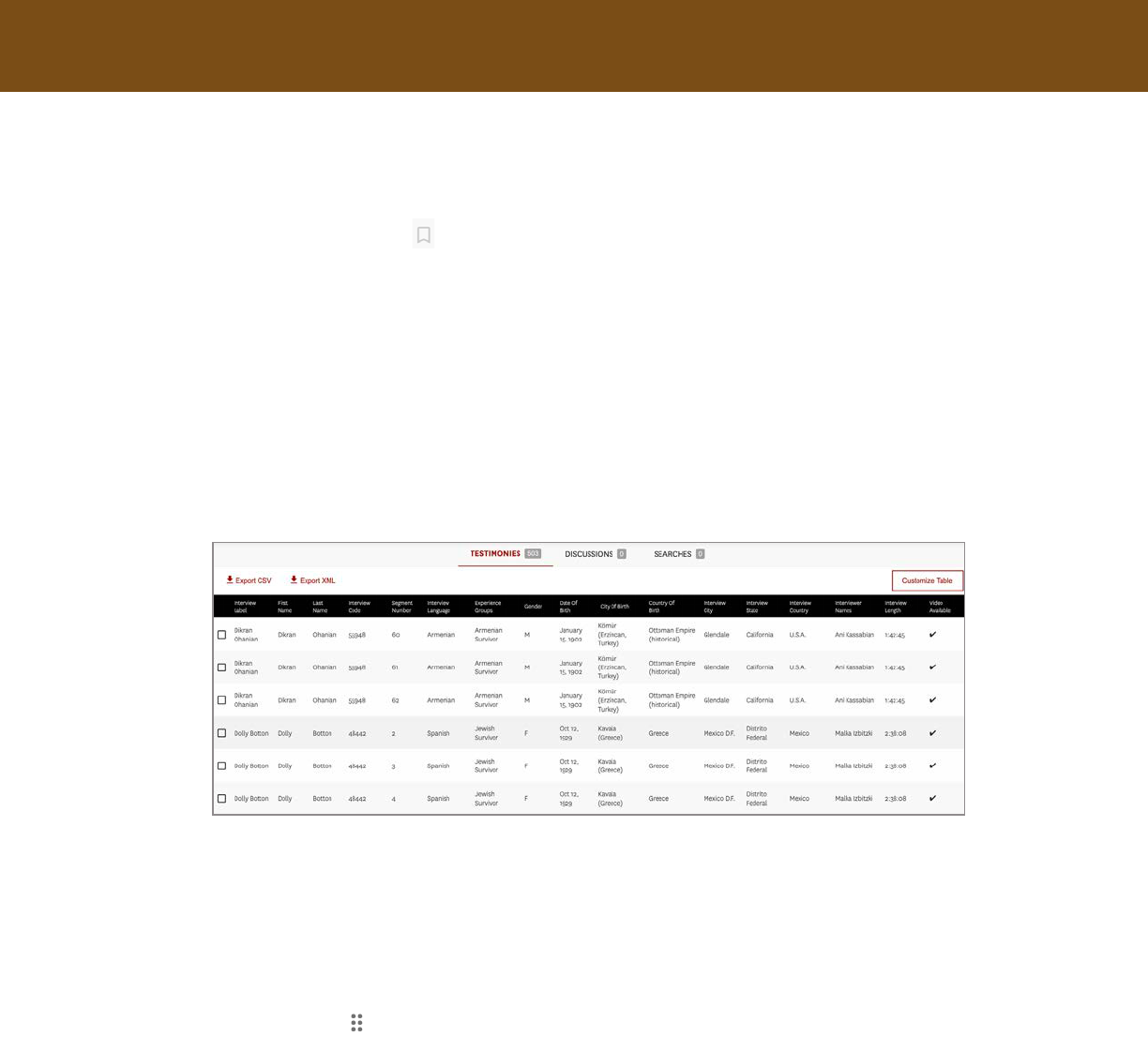
USC Shoah Foundation | 41
Visual History Archive (VHA) User Manual
Bookmarking a Project will add it to a list in the Bookmarked Projects tab of your Projects page. To
bookmark a Project, click the icon. e icon shape will then be lled in to indicate that the Project
has been bookmarked. Similarly, click a shaded bookmark icon to un-bookmark the Project.
e Share Project function generates a link to your project you can copy to your clipboard,
allowing for easier distribution of your work.
TeSTimonieS in projecTS
When rst viewing a Project in your Visual History Archive account, it will open by default to
the Testimonies tab. Here, you will see a table presenting all testimonies and segments of testimonies
that you have saved to the Project in a grid, accompanied by connected metadata.
If a row in the Testimonies tab corresponds to a single segment, the segment number will display
in the Segment Number column. If the row corresponds to a full testimony, the Segment Number
column will be populated with the word All.
e metadata columns that appear in the tables in your Projects can be rearranged; they can also
be removed, and added back in once removed. To make any of these edits, click Customize Table (in
the top right of image above). In the pop-up window that appears, you may toggle columns on or o,
or click and drag the symbols on the left to change the left-to-right order in which they appear. Be
sure to click Save when nished.
Any changes made with the Customize Table function are automatically applied to all of your
Projects, and they will remain whenever you log into your account. To return to the default layout at
any time, click Reset at the bottom of your Customize Your Table window, and then click Save.
e Testimonies list in Projects allows you to view 10 rows (segments or full testimonies) at a
time. For processing and manipulating larger amounts of data, users may wish to use the Export CSV
or Export XML functions to download .csv and .xml les, respectively, of the full content of the
Project’s Testimonies list. ese can then be opened in any software on your device that can read those
letypes.
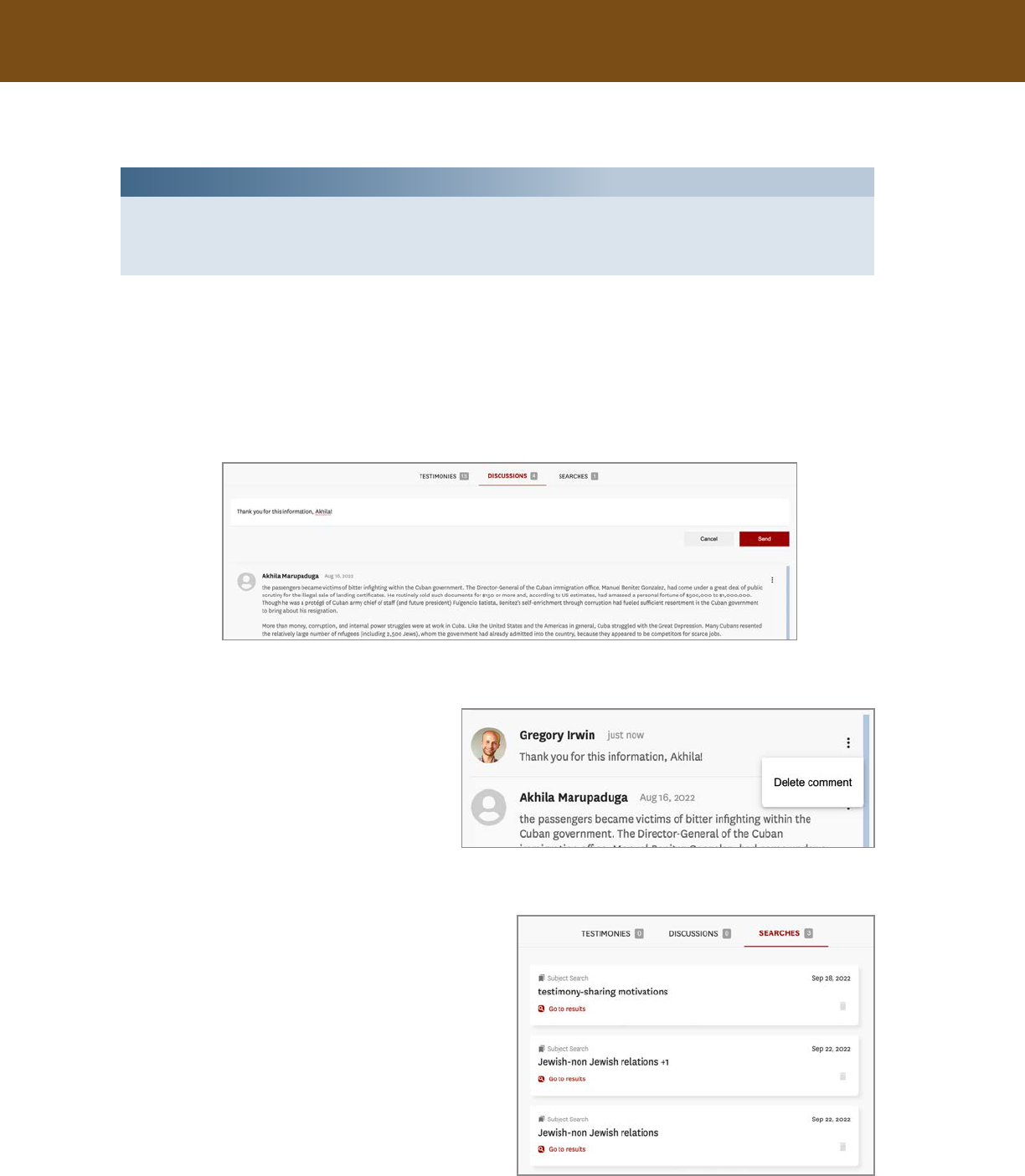
42 | USC Shoah Foundation
Visual History Archive (VHA) User Manual
diScUSSionS
e second tab available under each Project is Discussions, where users in a public, shared Project
can exchange ideas and resources, or users in a private Project may choose to store notes on their work.
Anyone with permissions to access a particular Project will have the ability to contribute comments in
the Discussions tab.
Discussion comments are sorted so the most recent comments appear on top of the list. e name
and thumbnail image associated with each
commenting user is displayed here.
To delete a comment that you posted,
click the vertical ellipsis and then click
Delete Comment.
SeArcheS
e third tab included with each Project is
Searches, where all saved search parameters are
stored (see page 12 of this User Manual, under
Saving Searches and Search Results).
Simply click the card corresponding to the
saved search parameters you want to revisit, and
the page will refresh to a search with the precise
conditions that you saved.
Note:
Edits to the table content or structure made with the Customize Table function will not apply to
.csv or .xml downloads. When downloading a Project’s testimony list, all columns will be included
in a standardized, default arrangement.
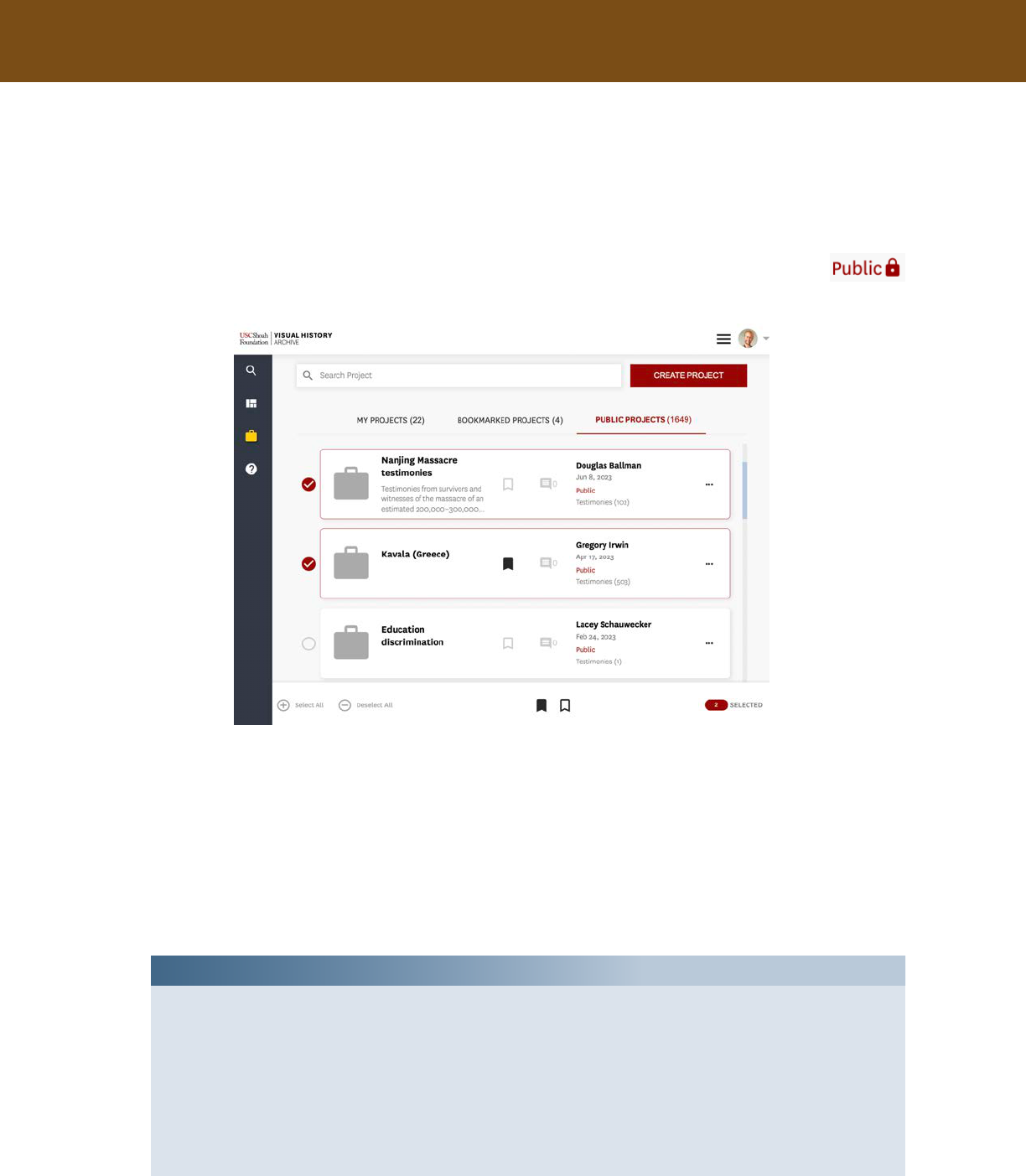
USC Shoah Foundation | 43
Visual History Archive (VHA) User Manual
pUblic projecTS
From the Projects homepage, you can visit the Public Projects tab to view the full list of projects
that have been made public to all Visual History Archive users. is list includes Projects
that are password-protected, as indicated by the red lock icon appearing beside the word
Public.
Click any public Project to open it. Unless you are limited by password access, you will have
full access to the Testimonies and Searches tabs, and you will be able to contribute comments in
Discussions.
You may also click Copy to My Projects to create a clone of the project, private in your account,
with all testimonies saved in the Testimonies tab (although Discussions and Searches will be empty).
You may then add testimonies, segments, search parameters and discussion comments to this new
duplicate version of the Project, now in your VHA account.
Note:
There is a large (and ever growing) collection of Projects included in the Public Projects list.
To help you find content relevant to your interests, try using the Projects search bar at the top of
the Projects homepage, which will present suggested Projects based on free text that you enter.
To keep track of multiple public Projects for future review, try clicking the bubbles om the left of
the Projects on the Public Projects list. As seen at the bottom of the screenshot above, this opens
a function that will allow you to bookmark or un-bookmark multiple Projects at the same time.
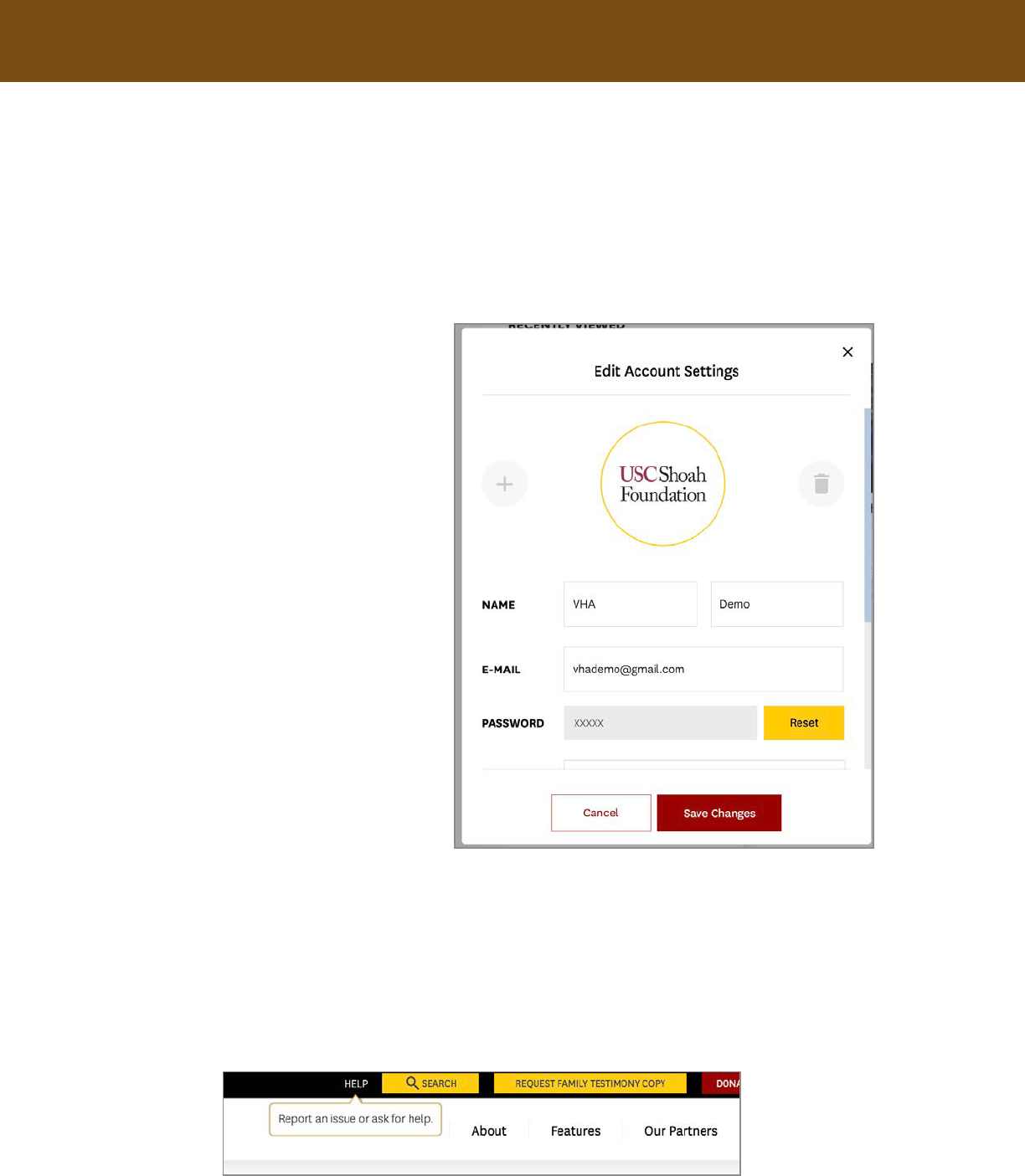
44 | USC Shoah Foundation
Visual History Archive (VHA) User Manual
Account and Password Management
To edit any of your registration info or reset your password, either click your name and photo in
the top-right of your Visual History Archive window and then click Account Settings, or click the red
pencil icon beside your name on your Dashboard. Either pathway will open the Edit Account Settings
pop-up window.
Among the most useful features in
this menu include: changing your VHA
account email, resetting your password
and altering the name and image
associated with your account.
To change any account details, either
edit the corresponding text or select a
dierent option in the dropdown menus.
To reset a password, click the yellow
Reset button. en, enter your current
password, followed by the desired text for
your new password.
To change your account image, click
the plus icon to the left. To delete your
account image, click the trash can to the
right.
No alterations made here are nal
until Save Changes is clicked. Closing
the Edit Account Settings pop-up without
saving is equivalent to clicking Cancel.
Help for VHA Users
In addition to this User Manual, USC Shoah Foundation oers extensive online support for users
of the Visual History Archive.
Click Help at the top of your VHA window to send an email to the VHA team at USC Shoah
Foundation. ey will do their best to meet your technical and content needs in a timely fashion.
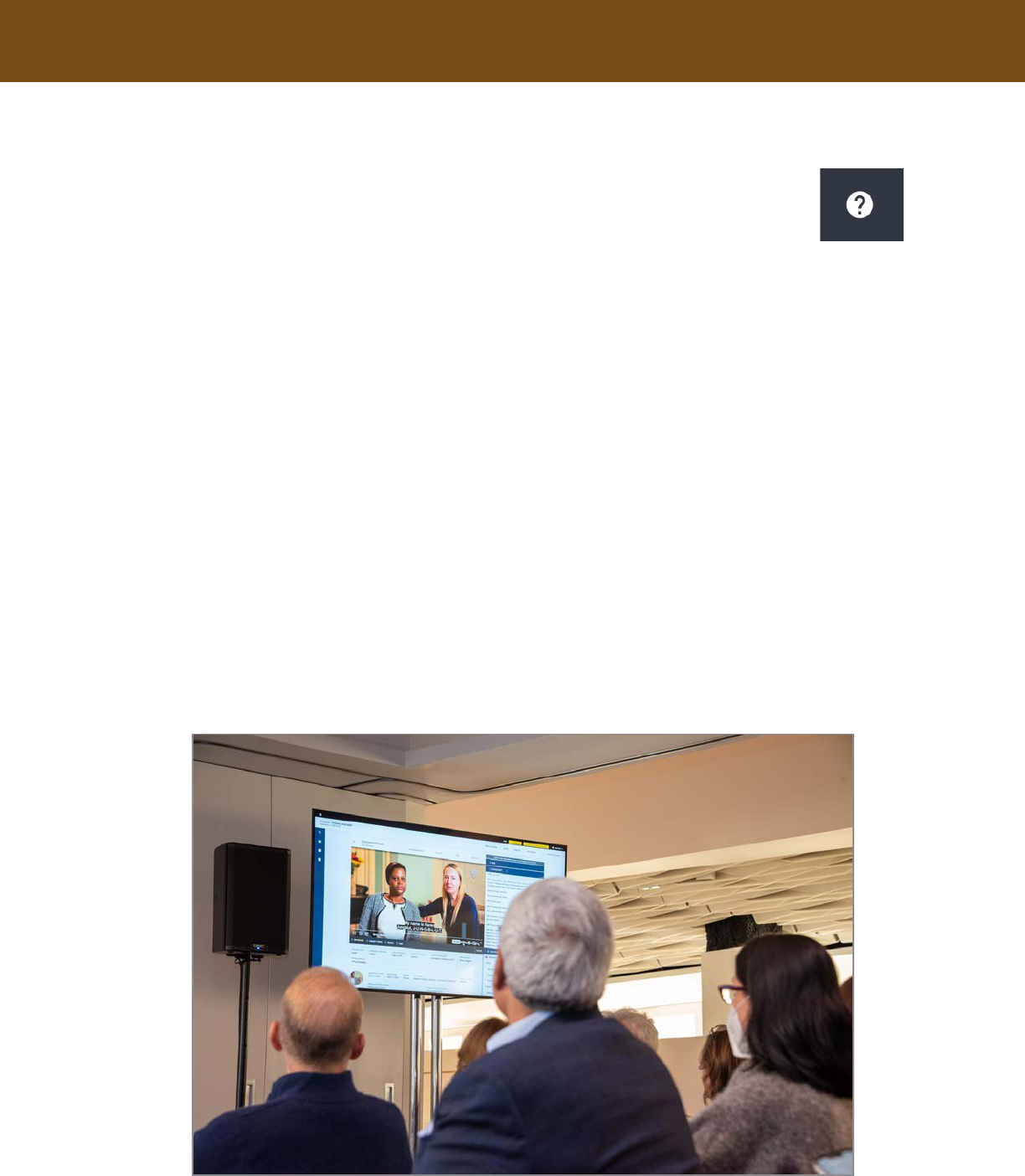
USC Shoah Foundation | 45
Visual History Archive (VHA) User Manual
Further supportive resources can be accessed on the Help page, available by clicking
the question mark icon in the left sidebar, or through a link the appears upon clicking
the aforementioned Help button at the top of the page.
e Help page oers video tutorials and answers to frequently asked questions regarding the VHA
in general, search functions and projects.
Contact USC Shoah Foundation
To get in touch with USC Shoah Foundation regarding the Visual History Archive, please email
For general questions about USC Shoah Foundation, please email [email protected] or call
(213) 740-6001
To reach USC Shoah Foundation by mail:
USC Shoah Foundation - e Institute for Visual History and Education
Leavey Library
650 W. 35th Street, Suite 401
Los Angeles, CA 90089-2571
